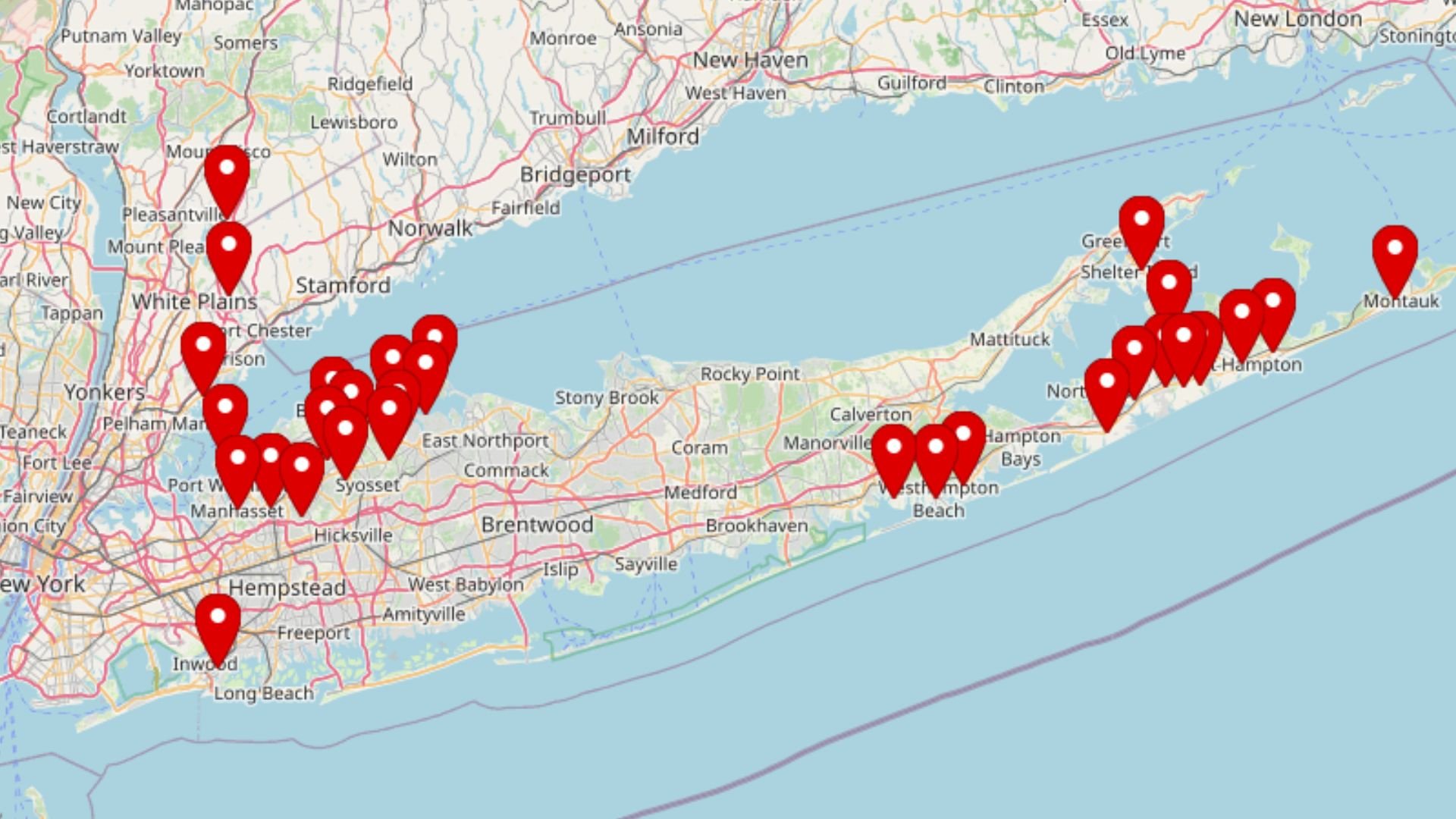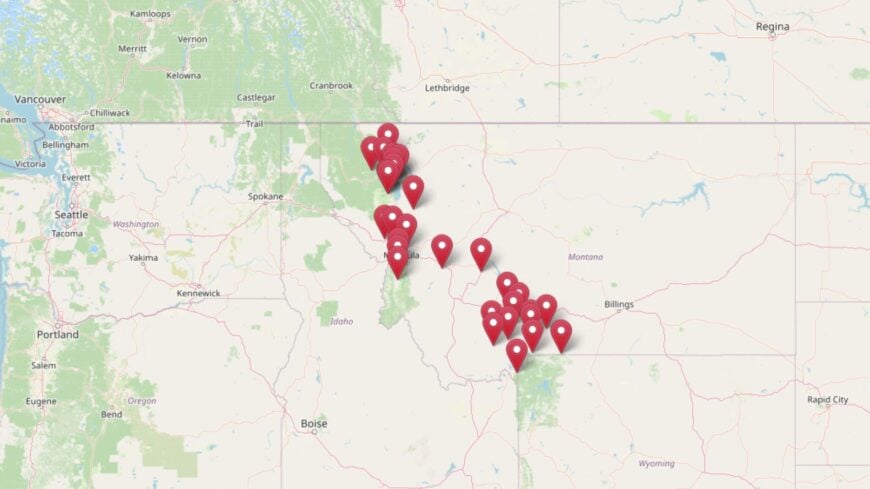
Using the latest Zillow Home Value Index data, we’ve ranked the 30 most expensive towns in Montana based on current home prices. These communities represent more than just high price tags—they showcase Montana’s transformation from rural ranching state to premium destination for luxury living. Big Sky leads at nearly $1.9 million median home value, while resort towns and gateway communities dominate the rankings.
From ski resort enclaves to Yellowstone gateway towns, each location reflects powerful market forces driving Montana real estate. Whether you’re tracking investment opportunities, planning a move, or simply curious about where Montana’s housing market peaks, this breakdown reveals the state’s most valuable residential markets and the stories behind their remarkable price growth.
30. Stevensville – 194% Home Price Increase Since 2010
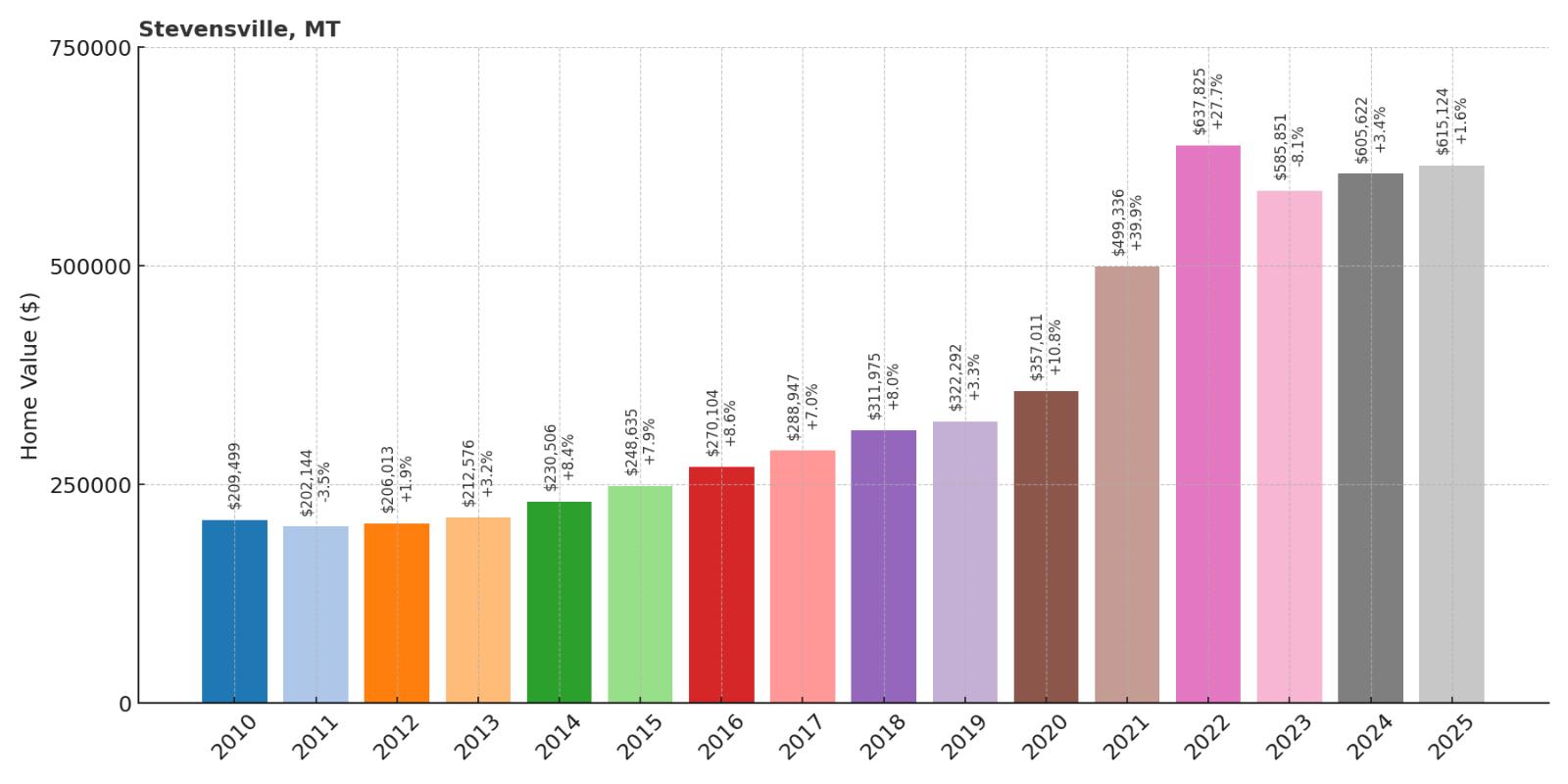
- 2010: $209,499
- 2011: $202,144
- 2012: $206,013
- 2013: $212,576
- 2014: $230,506
- 2015: $248,635
- 2016: $270,104
- 2017: $288,947
- 2018: $311,975
- 2019: $322,292
- 2020: $357,011
- 2021: $499,336
- 2022: $637,825
- 2023: $585,851
- 2024: $605,622
- 2025: $615,124
Stevensville has nearly tripled since 2010, reaching $615,000 in median home values by 2025. The Bitterroot Valley community showed steady growth throughout the period with pandemic acceleration driving substantial gains. Current values represent the area’s evolution from agricultural center to sought-after residential destination in southwestern Montana.
Why Stevensville?

Why are people willing to pay so much to live here? What’s special about it?
Stevensville combines historic charm with Bitterroot Valley recreation access and proximity to Missoula for employment and cultural activities. The area features established downtown amenities and residential neighborhoods while maintaining rural character and mountain access. Properties range from historic homes to rural estates that appeal to various lifestyle preferences.
The community attracts buyers seeking authentic Montana town living with outdoor recreation access and reasonable proximity to larger cities. Stevensville offers small-town amenities and community feel while providing access to fishing, hiking, and mountain recreation. The area maintains agricultural heritage while evolving into a desirable residential destination.
How Stevensville Rose to Prominence
Stevensville holds the distinction of being Montana’s first permanent settlement, established as St. Mary’s Mission in 1841 by Jesuit missionaries. The community developed around the mission and grew as an agricultural center serving the Bitterroot Valley’s farming and ranching operations. Historic Fort Owen, built nearby in 1850, served as an important trading post and early commercial center.
Modern growth followed the broader development of the Bitterroot Valley as a recreational and residential destination. The community’s historic character and small-town amenities attracted buyers seeking authentic Montana living with cultural heritage. Recent appreciation reflects the area’s evolution from agricultural center to sought-after residential community while maintaining its historic charm and valley setting.
3 Interesting Tidbits
1. First Settlement – Stevensville is recognized as Montana’s first permanent settlement, established in 1841 as St. Mary’s Mission by Jesuit missionaries.
2. Historic Fort – The nearby Fort Owen, built in 1850, served as an important trading post and is now a state park preserving early Montana history.
3. Mission Heritage – The original St. Mary’s Mission church still stands in Stevensville, representing Montana’s earliest European settlement and religious history.
29. West Yellowstone – 189% Home Price Increase Since 2010
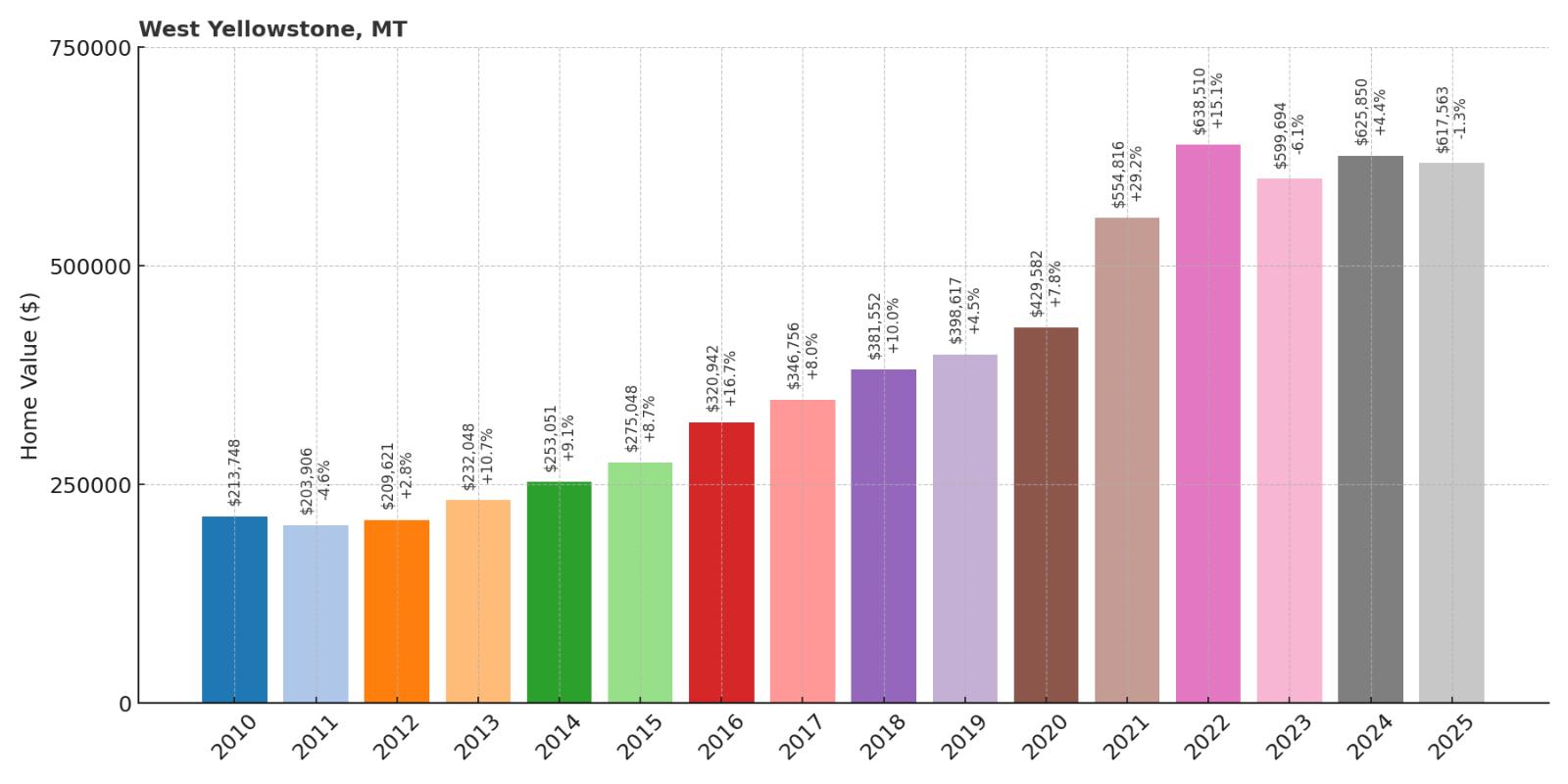
- 2010: $213,748
- 2011: $203,906
- 2012: $209,621
- 2013: $232,048
- 2014: $253,051
- 2015: $275,048
- 2016: $320,942
- 2017: $346,756
- 2018: $381,552
- 2019: $398,617
- 2020: $429,582
- 2021: $554,816
- 2022: $638,510
- 2023: $599,694
- 2024: $625,850
- 2025: $617,563
West Yellowstone has nearly tripled since 2010, reaching $618,000 in median home values by 2025. The Yellowstone gateway community showed consistent appreciation throughout the period with acceleration during pandemic years. Recent values reflect the area’s unique position as both a tourist destination and year-round residential community.
Why West Yellowstone?

Why are people willing to pay so much to live here? What’s special about it?
West Yellowstone serves as the primary gateway to Yellowstone National Park, transforming from a quiet community of 1,200 year-round residents to a vibrant hub during tourist season. The area provides direct access to the park’s geothermal features and wildlife while offering business opportunities related to tourism. Properties include both residential homes and commercial opportunities that benefit from tourist traffic.
The community appeals to buyers seeking park access and business opportunities in one of America’s premier tourist destinations. West Yellowstone offers year-round recreation including snowmobiling, cross-country skiing, and summer park activities. The area provides authentic western town character with architecture featuring wood facades and frontier styling that attracts both residents and visitors.
How West Yellowstone Rose to Prominence
West Yellowstone developed as a railroad terminus serving Yellowstone National Park visitors, becoming the primary western entrance to the park in the early 1900s. The community grew around tourism services and seasonal businesses that catered to park visitors exploring America’s first national park. Railroad connections made it the most accessible entrance for many visitors.
Modern West Yellowstone evolved as automobile travel replaced rail transportation and year-round tourism increased. The community became known as the “snowmobile capital of the lower 48” while maintaining its role as the busiest gate to Yellowstone National Park. Property values increased as tourism grew and demand for gateway community real estate intensified.
3 Interesting Tidbits
1. Snowmobile Capital – West Yellowstone is known as the “snowmobile capital of the lower 48” with extensive trail systems and winter recreation opportunities.
2. Park Gateway – The community serves as the busiest entrance to Yellowstone National Park, handling more visitors than any other gateway town.
3. Seasonal Transformation – West Yellowstone’s population swells dramatically during tourist season, creating a dynamic atmosphere and business opportunities for residents.
28. Clancy – 146% Home Price Increase Since 2010
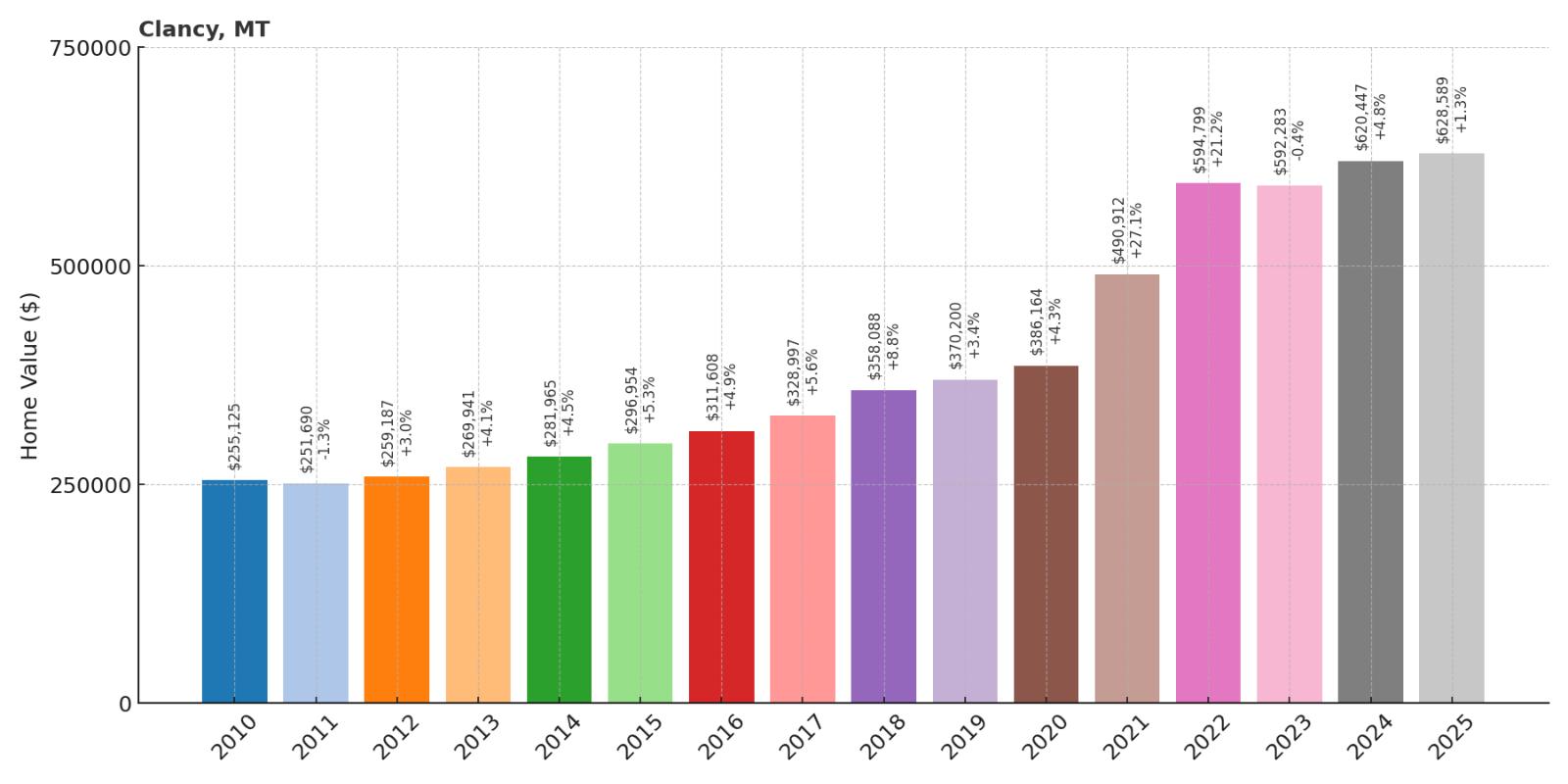
- 2010: $255,125
- 2011: $251,690
- 2012: $259,187
- 2013: $269,941
- 2014: $281,965
- 2015: $296,954
- 2016: $311,608
- 2017: $328,997
- 2018: $358,088
- 2019: $370,200
- 2020: $386,164
- 2021: $490,912
- 2022: $594,799
- 2023: $592,283
- 2024: $620,447
- 2025: $628,589
Clancy has more than doubled since 2010, reaching $629,000 in median home values by 2025. The Jefferson County community showed consistent growth throughout the period with steady acceleration. Current values reflect the area’s appeal as a rural residential destination with proximity to Helena and outdoor recreation access.
Why Clancy?

Why are people willing to pay so much to live here? What’s special about it?
Clancy offers rural lifestyle with mountain views and proximity to Helena for employment and state government activities. The area provides larger properties with space and privacy while maintaining reasonable commute times to Montana’s capital city. Properties feature mountain settings with access to outdoor recreation and authentic Montana living.
The community attracts government employees, retirees, and professionals seeking rural lifestyle with urban access. Clancy’s position provides mountain recreation opportunities while maintaining proximity to Helena’s employment and cultural amenities. The area offers value for those wanting space and natural beauty with capital city conveniences.
How Clancy Rose to Prominence
Clancy developed as a small rural community serving the agricultural and mining activities of Jefferson County. The area’s economy included both farming operations and mining activities that utilized local mineral resources. Early settlement was supported by railroad connections and proximity to Helena’s governmental and commercial activities.
Property appreciation followed Helena’s growth and increased demand for rural residential properties within commuting distance of the capital. The community’s rural character and mountain access attracted buyers seeking space and outdoor recreation. Recent growth reflects the premium placed on properties that combine rural lifestyle with urban proximity.
3 Interesting Tidbits
1. Capital Proximity – Clancy provides rural living while maintaining reasonable commute times to Helena’s government employment and services.
2. Mountain Setting – The community sits in a mountain valley setting that provides both scenic beauty and access to outdoor recreation opportunities.
3. Rural Character – Clancy maintains small-town and rural atmosphere while providing modern conveniences and proximity to larger communities.
27. Ennis – 120% Home Price Increase Since 2016
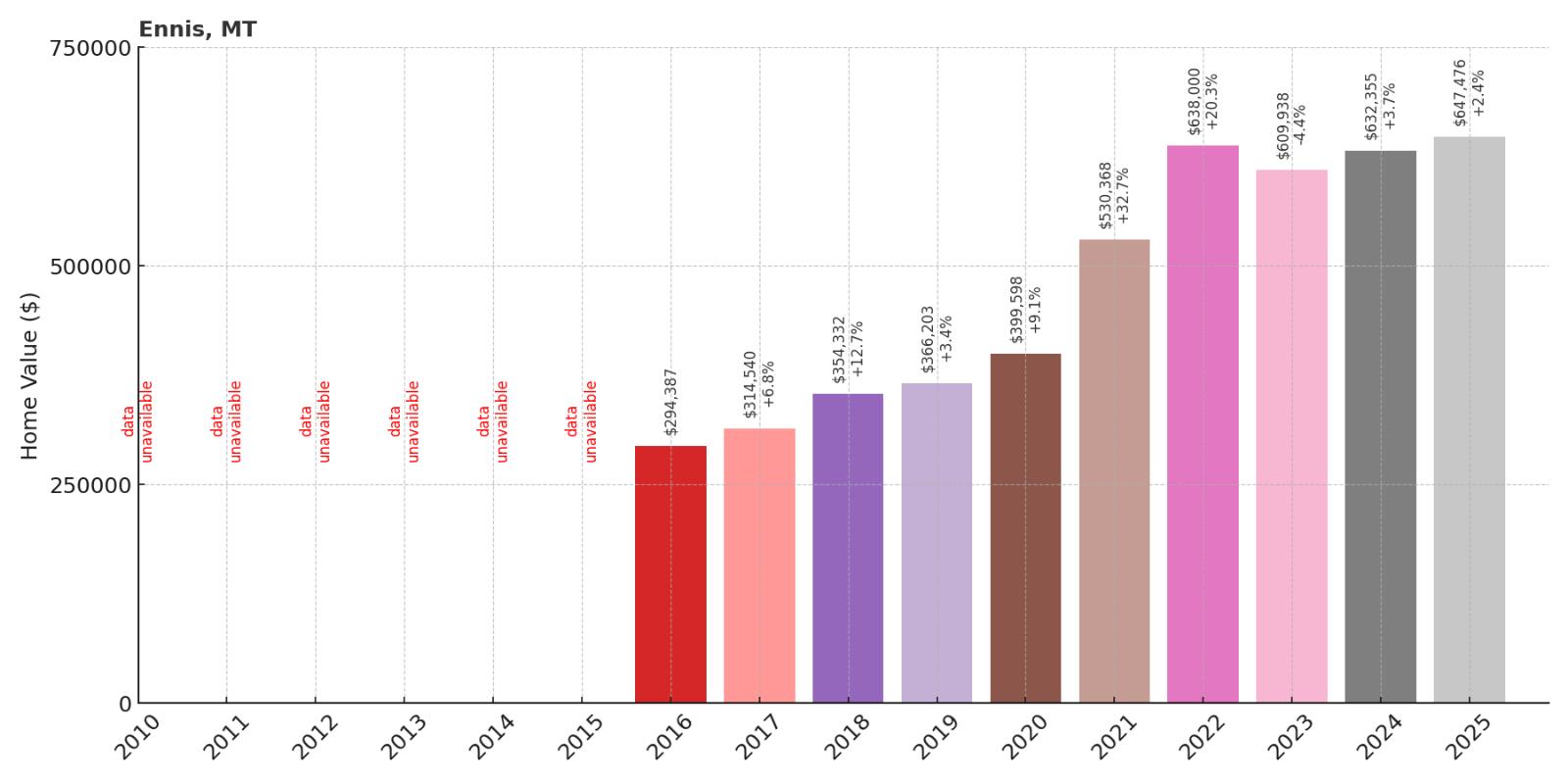
- 2010: N/A
- 2011: N/A
- 2012: N/A
- 2013: N/A
- 2014: N/A
- 2015: N/A
- 2016: $294,387
- 2017: $314,540
- 2018: $354,332
- 2019: $366,203
- 2020: $399,598
- 2021: $530,368
- 2022: $638,000
- 2023: $609,938
- 2024: $632,355
- 2025: $647,476
Ennis has more than doubled since 2016, reaching $647,000 in median home values by 2025. The Madison Valley community showed steady growth through 2020 before pandemic acceleration drove substantial appreciation. Recent stabilization around current levels reflects the area’s established position as a fishing destination and rural residential market.
Why Ennis?

Why are people willing to pay so much to live here? What’s special about it?
Ennis sits in the heart of the Madison River valley, providing access to some of the world’s most famous trout fishing waters. The area offers authentic western town character with fly fishing shops, guides, and amenities that serve anglers from around the globe. Properties feature river access and mountain views in a setting that maintains traditional ranching heritage.
The community attracts fishing enthusiasts and buyers seeking authentic Montana small-town living with world-class recreation access. Ennis provides the charm of a working western town while offering proximity to Madison River fishing and mountain recreation. The area appeals to those wanting genuine Montana experience without resort development or tourist crowds.
How Ennis Rose to Prominence
Ennis developed as a ranching and agricultural center in the Madison Valley, serving livestock operations and hay production throughout southwestern Montana. The community grew around railroad connections that provided market access for agricultural products and seasonal shipping of cattle. Early development focused on supporting the valley’s extensive ranching operations.
The transformation to a fishing destination began as the Madison River gained recognition among anglers and outdoor recreation increased throughout the region. Ennis evolved into a hub for fishing guides, outfitters, and related services while maintaining its agricultural heritage. Recent property appreciation reflects the premium placed on fishing access and authentic western town character.
3 Interesting Tidbits
1. Fishing Capital – Ennis is considered the fly fishing capital of Montana, with the Madison River providing world-renowned trout fishing opportunities.
2. Rodeo Heritage – The community hosts an annual rodeo that celebrates the area’s ranching heritage and attracts visitors from throughout the region.
3. Valley Center – Ennis serves as the commercial and cultural center for the Madison Valley’s ranching and recreational activities.
26. Manhattan – 176% Home Price Increase Since 2010
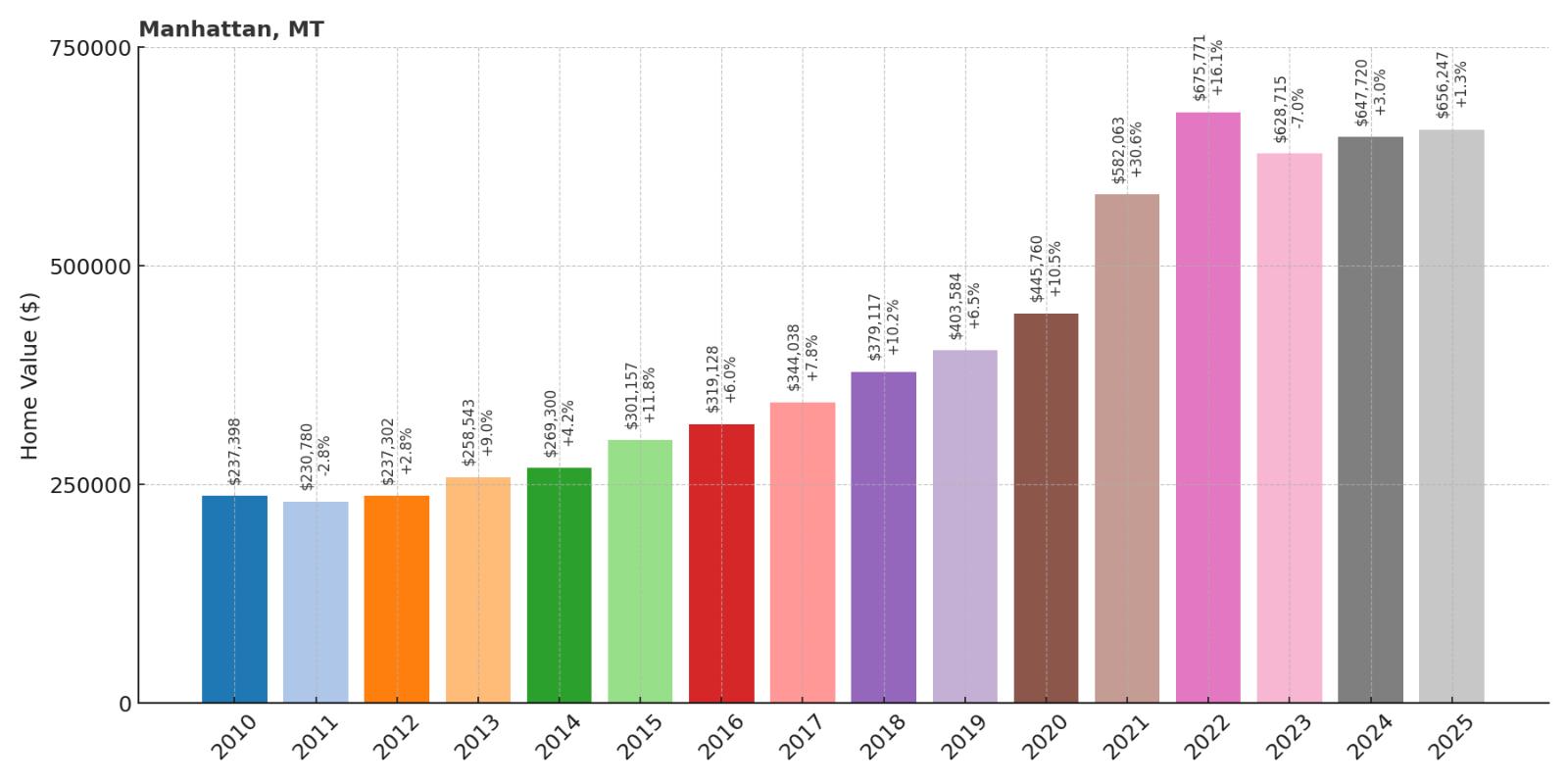
- 2010: $237,398
- 2011: $230,780
- 2012: $237,302
- 2013: $258,543
- 2014: $269,300
- 2015: $301,157
- 2016: $319,128
- 2017: $344,038
- 2018: $379,117
- 2019: $403,584
- 2020: $445,760
- 2021: $582,063
- 2022: $675,771
- 2023: $628,715
- 2024: $647,720
- 2025: $656,247
Manhattan has nearly tripled since 2010, reaching $656,000 in median home values by 2025. The Gallatin County community showed consistent growth throughout the period with steady acceleration through 2020. Pandemic years brought substantial appreciation before recent stabilization around current levels.
Why Manhattan?

Why are people willing to pay so much to live here? What’s special about it?
Manhattan provides small-town living with access to Bozeman’s employment and amenities while offering more space and rural character. The area features agricultural properties and rural residential lots that appeal to buyers seeking authentic Montana lifestyle. Properties provide mountain views and space for various activities while maintaining proximity to urban conveniences.
The community attracts buyers who want to be near Bozeman’s opportunities while maintaining rural lifestyle and property space. Manhattan offers agricultural heritage and small-town character with easy access to Montana State University and Bozeman’s cultural amenities. The area provides value for those seeking rural living with urban proximity.
How Manhattan Rose to Prominence
Manhattan developed as an agricultural center in the Gallatin Valley, serving farming operations and providing services for rural residents. The area’s economy focused on potato farming, livestock, and hay production that utilized fertile valley soil. Railroad connections provided market access for agricultural products and supported community development.
Property values increased as Bozeman’s growth expanded throughout Gallatin County and demand for rural residential properties increased. The community’s agricultural heritage and small-town character attracted buyers seeking authentic Montana living. Recent appreciation reflects the area’s position within the broader Bozeman market while maintaining rural appeal.
3 Interesting Tidbits
1. Potato Fame – Manhattan historically served as a center for potato farming in the Gallatin Valley, with operations that supplied regional markets.
2. Small Town – The community maintains small-town character with local businesses and services while providing access to Bozeman’s larger amenities.
3. Agricultural Center – Manhattan continues to serve as a hub for Gallatin County’s agricultural operations, supporting both traditional farming and modern residential development.
25. Florence – 169% Home Price Increase Since 2010
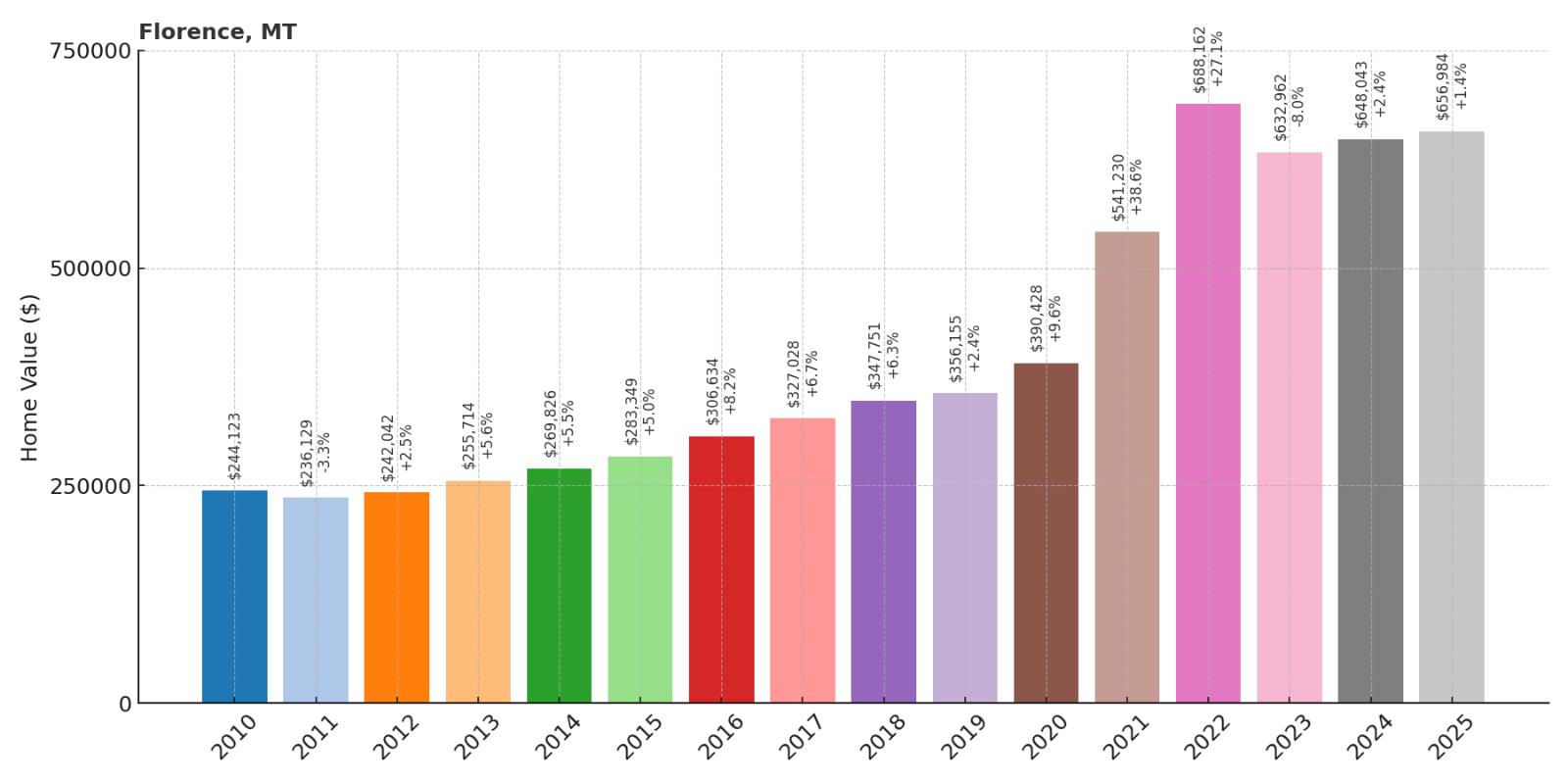
- 2010: $244,123
- 2011: $236,129
- 2012: $242,042
- 2013: $255,714
- 2014: $269,826
- 2015: $283,349
- 2016: $306,634
- 2017: $327,028
- 2018: $347,751
- 2019: $356,155
- 2020: $390,428
- 2021: $541,230
- 2022: $688,162
- 2023: $632,962
- 2024: $648,043
- 2025: $656,984
Florence has more than doubled since 2010, reaching $657,000 in median home values by 2025. The Bitterroot Valley community showed consistent growth throughout the period with pandemic acceleration bringing substantial gains. Current values reflect stabilization around levels that maintain Florence’s position in Montana’s growing luxury market.
Why Florence?

Why are people willing to pay so much to live here? What’s special about it?
Florence offers Bitterroot Valley lifestyle with mountain recreation access and proximity to Missoula for employment and cultural activities. The area provides rural properties with space and views while maintaining reasonable access to urban amenities and services. Properties feature mountain settings with river access and agricultural heritage.
The community attracts buyers seeking authentic Montana living with outdoor recreation access and space for various lifestyle activities. Florence’s position in the Bitterroot Valley provides access to hiking, fishing, and hunting while offering larger properties than urban areas. The area combines natural beauty with practical advantages for those wanting rural lifestyle with city proximity.
How Florence Rose to Prominence
Florence developed as an agricultural center in the Bitterroot Valley, serving farming and ranching operations in southwestern Montana. The area’s agricultural economy focused on livestock and hay production that utilized valley land and seasonal mountain grazing. Railroad connections and highway access supported agricultural markets and early settlement.
Property appreciation followed broader trends in the Bitterroot Valley as recreational demand and residential interest increased. The community’s agricultural heritage and rural character attracted buyers seeking authentic Montana lifestyle with modern conveniences. Recent growth reflects continued demand for rural properties with recreation access and natural beauty.
3 Interesting Tidbits
1. Valley Agriculture – Florence maintains working agricultural operations that continue traditional farming and ranching activities alongside residential development.
2. Mountain Access – The community provides access to the Bitterroot National Forest and Selway-Bitterroot Wilderness for hiking and backcountry recreation.
3. Regional Hub – Florence serves as a small service center for the southern Bitterroot Valley, providing local amenities and community services.
24. Corvallis – 181% Home Price Increase Since 2010
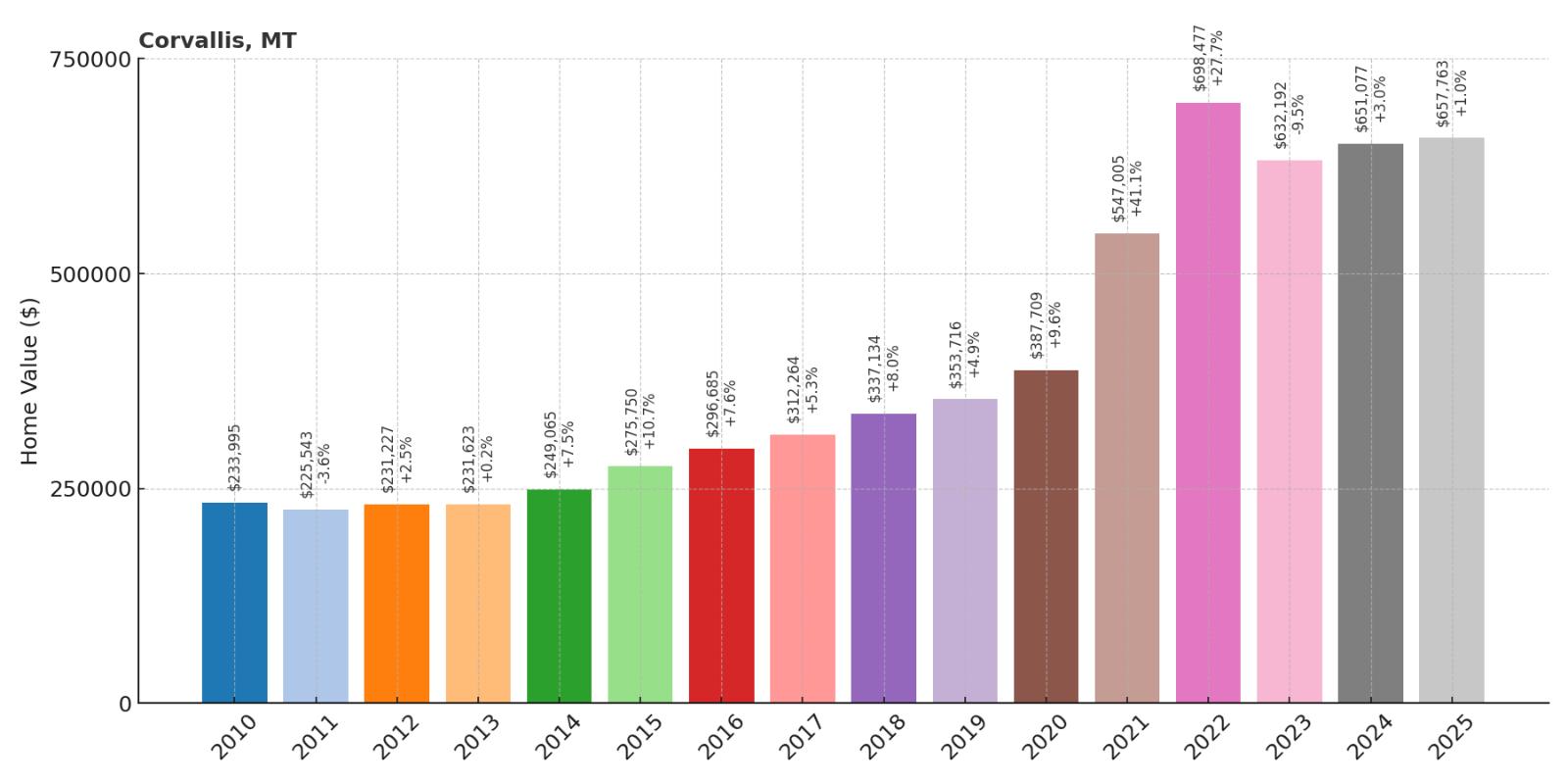
- 2010: $233,995
- 2011: $225,543
- 2012: $231,227
- 2013: $231,623
- 2014: $249,065
- 2015: $275,750
- 2016: $296,685
- 2017: $312,264
- 2018: $337,134
- 2019: $353,716
- 2020: $387,709
- 2021: $547,005
- 2022: $698,477
- 2023: $632,192
- 2024: $651,077
- 2025: $657,763
Corvallis has nearly tripled since 2010, reaching $658,000 in median home values by 2025. The Bitterroot Valley community showed steady appreciation throughout the period with pandemic acceleration driving substantial gains. Current values represent stabilization around levels that reflect the area’s appeal as a recreational and residential destination.
Why Corvallis?

Why are people willing to pay so much to live here? What’s special about it?
Corvallis sits in the scenic Bitterroot Valley with mountain views and access to outdoor recreation including fishing, hiking, and hunting. The area provides rural lifestyle with larger properties while maintaining proximity to Missoula and Hamilton for amenities. Properties offer space and natural beauty that appeal to buyers seeking authentic Montana living.
The community attracts those wanting Bitterroot Valley lifestyle with mountain access and agricultural heritage. Corvallis offers river access and recreational opportunities while maintaining rural character and community feel. The area provides value within Montana’s luxury market for buyers prioritizing space and outdoor access.
How Corvallis Rose to Prominence
Corvallis developed as an agricultural community in the Bitterroot Valley, serving farming and ranching operations in southwestern Montana. The area’s fertile soil and favorable climate supported diverse agricultural activities including apple orchards and hay production. Early settlement was drawn by agricultural potential and natural beauty.
Property values increased as the Bitterroot Valley gained recognition as a recreational destination and residential alternative to more expensive areas. The community’s rural character and agricultural heritage attracted buyers seeking authentic Montana lifestyle. Recent appreciation reflects broader trends affecting rural communities with recreation access and natural beauty.
3 Interesting Tidbits
1. Apple Heritage – The Bitterroot Valley around Corvallis historically supported extensive apple orchards, with some operations still maintaining fruit production.
2. Valley Views – Properties feature views of the Bitterroot Mountains to the west and Sapphire Mountains to the east, creating dramatic valley scenery.
3. River Access – The Bitterroot River through the area provides fishing and recreational opportunities while supporting the valley’s agricultural irrigation needs.
23. McLeod – 161% Home Price Increase Since 2013
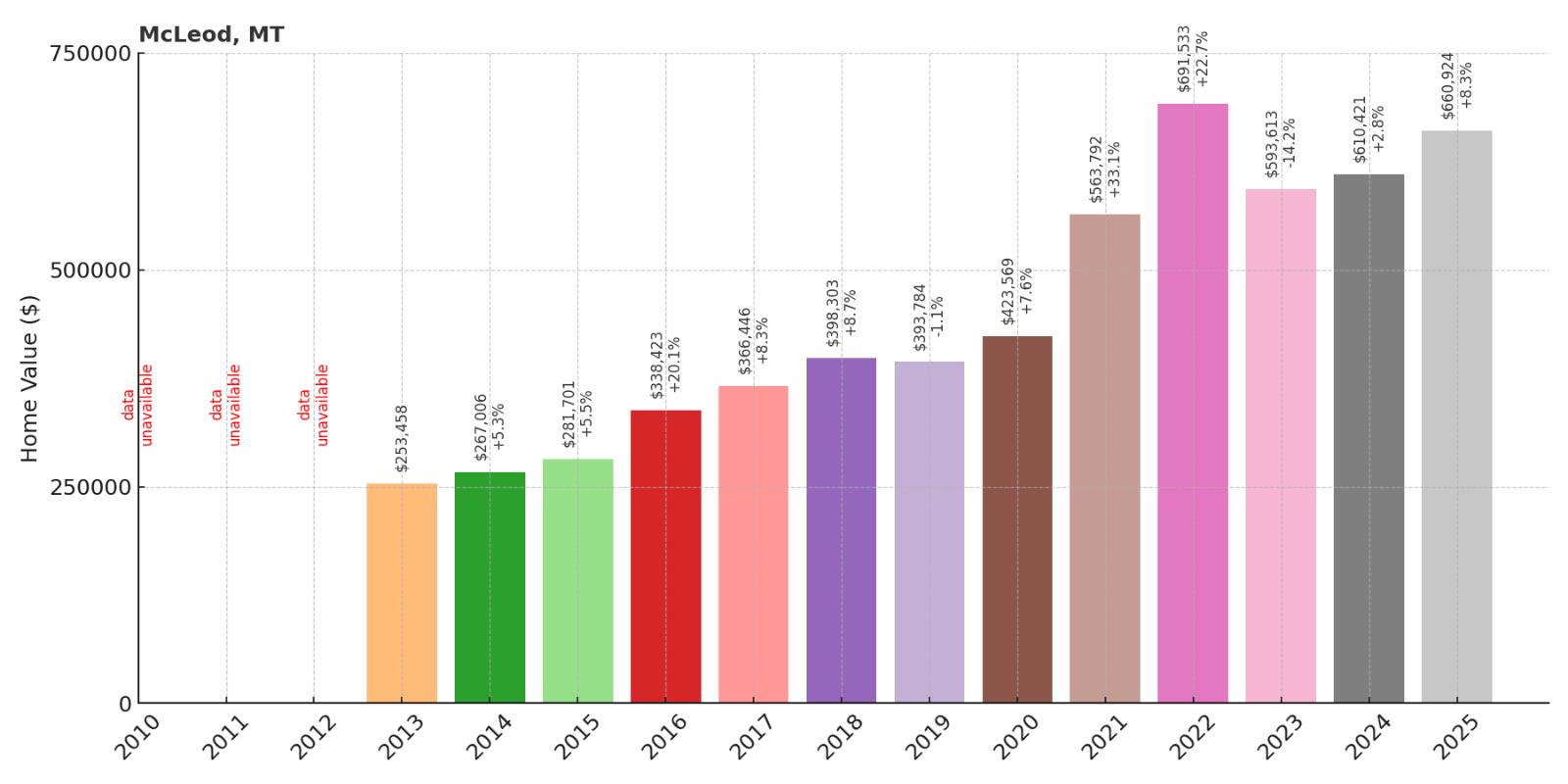
- 2010: N/A
- 2011: N/A
- 2012: N/A
- 2013: $253,458
- 2014: $267,006
- 2015: $281,701
- 2016: $338,423
- 2017: $366,446
- 2018: $398,303
- 2019: $393,784
- 2020: $423,569
- 2021: $563,792
- 2022: $691,533
- 2023: $593,613
- 2024: $610,421
- 2025: $660,924
McLeod has more than doubled since 2013, reaching $661,000 in median home values by 2025. The Sweet Grass County community experienced accelerating growth through 2018 before pandemic years brought substantial appreciation. Recent fluctuations reflect market adjustments, with current values representing strong gains from the starting point.
Why McLeod?

Why are people willing to pay so much to live here? What’s special about it?
McLeod provides access to the Yellowstone River and mountain recreation in south-central Montana while maintaining rural character and space. The area offers ranch properties and recreational access with proximity to both Yellowstone National Park and the Beartooth Mountains. Properties feature river access and mountain views in an authentic ranching setting.
The community appeals to buyers seeking traditional Montana ranch lifestyle with excellent fishing and outdoor recreation access. McLeod’s position provides access to multiple mountain ranges and river systems while maintaining agricultural heritage. The area offers value for those prioritizing outdoor recreation and authentic Montana living over resort amenities.
How McLeod Rose to Prominence
McLeod developed as a small ranching community in the Yellowstone River valley, serving agricultural operations and seasonal grazing activities. The area’s economy centered on cattle ranching and hay production that utilized valley bottomland and mountain grazing areas. Early settlement was supported by railroad access and agricultural potential.
Property appreciation followed increased interest in recreational and fishing properties throughout the Yellowstone region. The community’s river access and ranch character attracted buyers seeking outdoor recreation and authentic Montana lifestyle. Recent growth reflects the premium placed on river access and proximity to recreational opportunities.
3 Interesting Tidbits
1. River Access – McLeod sits along the Yellowstone River, providing access to world-class trout fishing and recreational floating opportunities.
2. Ranch Country – The area maintains working cattle ranches that continue traditional Montana agricultural operations alongside residential properties.
3. Mountain Gateway – McLeod provides access to the Beartooth Mountains and Yellowstone National Park for hiking, fishing, and wilderness recreation.
22. Frenchtown – 174% Home Price Increase Since 2010
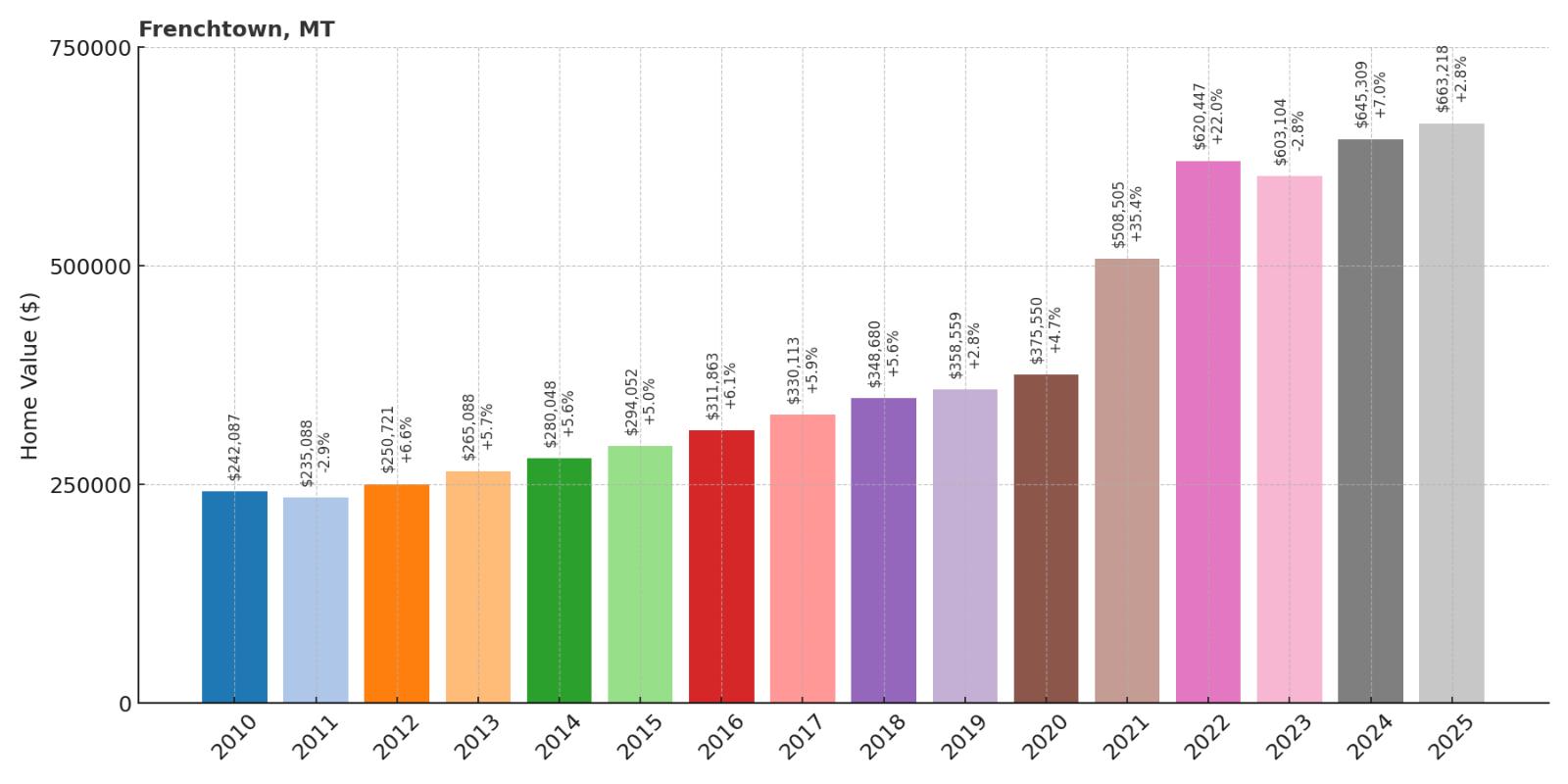
- 2010: $242,087
- 2011: $235,088
- 2012: $250,721
- 2013: $265,088
- 2014: $280,048
- 2015: $294,052
- 2016: $311,863
- 2017: $330,113
- 2018: $348,680
- 2019: $358,559
- 2020: $375,550
- 2021: $508,505
- 2022: $620,447
- 2023: $603,104
- 2024: $645,309
- 2025: $663,218
Frenchtown has nearly tripled since 2010, reaching $663,000 in median home values by 2025. The Missoula County community showed consistent growth throughout the period with pandemic acceleration driving substantial gains. Current values reflect the area’s appeal as a rural community with river access and proximity to Missoula.
Why Frenchtown?

Why are people willing to pay so much to live here? What’s special about it?
Frenchtown offers rural lifestyle along the Clark Fork River while maintaining convenient access to Missoula’s employment and amenities. The area provides river properties and mountain views with space for agricultural activities or large residential lots. Properties appeal to buyers seeking authentic Montana living with modern conveniences nearby.
The community combines river access with proximity to university culture and outdoor recreation opportunities throughout western Montana. Frenchtown’s position provides fishing and water activities while maintaining commutable distance to Missoula. The area offers balance between rural space and urban access that appeals to many buyers.
How Frenchtown Rose to Prominence
Frenchtown began as an agricultural community along the Clark Fork River, serving farming and ranching operations in the Missoula area. The area’s fertile bottomland and water access supported agricultural activities and early settlement. Railroad and highway connections provided market access and transportation advantages.
Property values increased as Missoula grew and demand for rural residential properties expanded beyond city limits. The community’s river access and rural character attracted buyers seeking space and water activities. Recent appreciation reflects broader Montana market trends and continued demand for properties with river access and mountain recreation.
3 Interesting Tidbits
1. River Community – Frenchtown sits along the Clark Fork River, Montana’s largest river by volume, providing fishing and recreation opportunities.
2. Agricultural Heritage – The area maintains working farms and ranches that continue traditional agricultural operations alongside residential development.
3. Commuter Access – Frenchtown provides rural lifestyle while maintaining reasonable access to Missoula for employment and university activities.
21. Condon – 201% Home Price Increase Since 2010
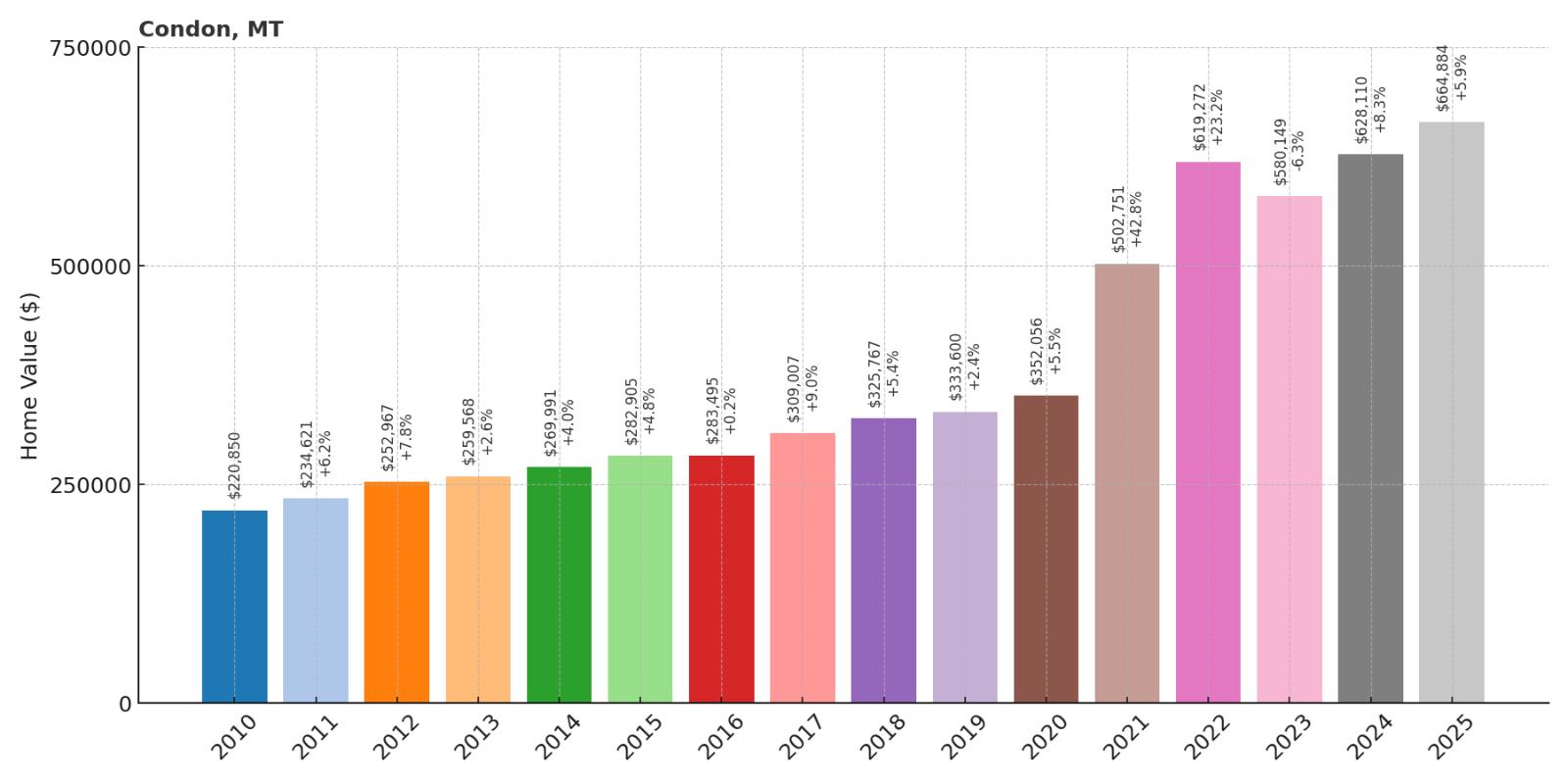
- 2010: $220,850
- 2011: $234,621
- 2012: $252,967
- 2013: $259,568
- 2014: $269,991
- 2015: $282,905
- 2016: $283,495
- 2017: $309,007
- 2018: $325,767
- 2019: $333,600
- 2020: $352,056
- 2021: $502,751
- 2022: $619,272
- 2023: $580,149
- 2024: $628,110
- 2025: $664,884
Condon has tripled in value since 2010, reaching $665,000 in median home prices by 2025. The Swan Valley community showed steady growth through 2020 before pandemic acceleration drove substantial appreciation. Recent gains reflect continued demand for properties in northwest Montana’s mountain communities with wilderness access.
Why Condon?

Why are people willing to pay so much to live here? What’s special about it?
Condon sits in the scenic Swan Valley between the Mission and Swan mountain ranges, providing access to pristine wilderness areas and outdoor recreation. The area offers mountain properties with privacy and natural beauty while maintaining access to Flathead region amenities. Properties feature forest settings and mountain views that appeal to buyers seeking seclusion and nature.
The community attracts those wanting authentic Montana mountain living with access to wilderness areas and outdoor activities. Condon’s position in the Swan Valley provides hiking, fishing, and hunting opportunities in a setting that remains largely undeveloped. The area offers escape from resort development while maintaining recreational access and natural beauty.
How Condon Rose to Prominence
Condon developed as a small logging and ranching community in the Swan Valley, serving timber operations and supporting agricultural activities. The area’s economy centered on forest products and seasonal ranching that took advantage of mountain valleys and natural resources. Early settlement was limited by the remote location and challenging access.
Property values increased as demand for remote mountain properties grew and buyers discovered the Swan Valley’s recreational opportunities. The area’s pristine setting and wilderness access attracted buyers seeking privacy and natural beauty. Recent appreciation reflects broader Montana trends and the premium placed on properties with wilderness access and mountain recreation.
3 Interesting Tidbits
1. Wilderness Gateway – Condon provides access to both the Mission Mountains Wilderness and Bob Marshall Wilderness Complex for backcountry recreation.
2. Swan Valley – The community sits in one of northwest Montana’s most scenic and undeveloped valleys, maintaining pristine natural character.
3. Forest Setting – Properties in Condon are surrounded by national forest land, providing privacy and recreational access while limiting development pressure.
20. Bonner – 153% Home Price Increase Since 2010
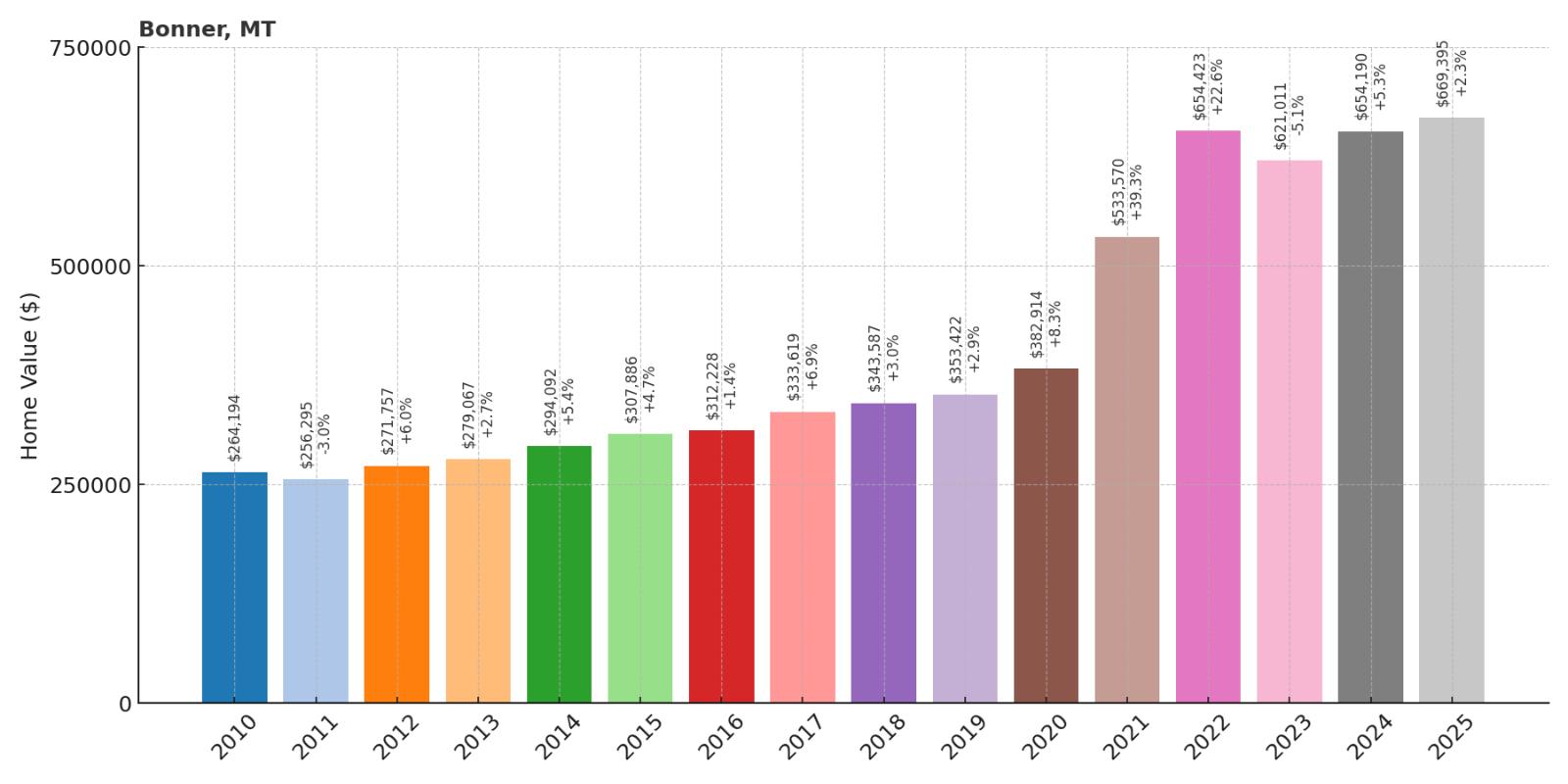
- 2010: $264,194
- 2011: $256,295
- 2012: $271,757
- 2013: $279,067
- 2014: $294,092
- 2015: $307,886
- 2016: $312,228
- 2017: $333,619
- 2018: $343,587
- 2019: $353,422
- 2020: $382,914
- 2021: $533,570
- 2022: $654,423
- 2023: $621,011
- 2024: $654,190
- 2025: $669,395
Bonner has more than doubled since 2010, reaching $669,000 in median home values by 2025. The Missoula County community showed steady appreciation throughout the period with acceleration during pandemic years. Recent stabilization around current levels reflects sustained demand for properties with river access and mountain recreation.
Why Bonner?

Why are people willing to pay so much to live here? What’s special about it?
Bonner sits along the Blackfoot River east of Missoula, providing access to blue-ribbon trout fishing and mountain recreation. The area offers river properties and mountain access while maintaining proximity to Missoula’s employment and cultural opportunities. Properties feature water access and outdoor recreation with university town conveniences nearby.
The community attracts outdoor enthusiasts seeking river lifestyle with mountain access and reasonable proximity to urban amenities. Bonner’s position along the Blackfoot River provides fishing and recreation opportunities made famous in literature and film. The area offers authentic Montana living with river access and mountain views.
How Bonner Rose to Prominence
Bonner developed as a mill town along the Blackfoot River, taking advantage of timber resources and water power for lumber operations. The area’s economy centered on forest products and supporting services for the timber industry. Railroad connections provided transportation for lumber products and access for early residents.
The transition to recreational and residential focus followed the decline of timber operations and increased interest in river recreation and fishing. The Blackfoot River’s reputation for trout fishing and natural beauty attracted buyers seeking water access and outdoor lifestyle. Recent development has focused on properties that take advantage of river access while maintaining the area’s natural character.
3 Interesting Tidbits
1. Literary Fame – The Blackfoot River through Bonner was featured in Norman Maclean’s “A River Runs Through It,” bringing national attention to the area’s fishing opportunities.
2. Mill Heritage – Historic lumber mill operations shaped the community’s development and infrastructure, with some mill structures still visible today.
3. River Access – Bonner provides public access to the Blackfoot River for fishing, floating, and other water activities popular with both residents and visitors.
19. Somers – 121% Home Price Increase Since 2010
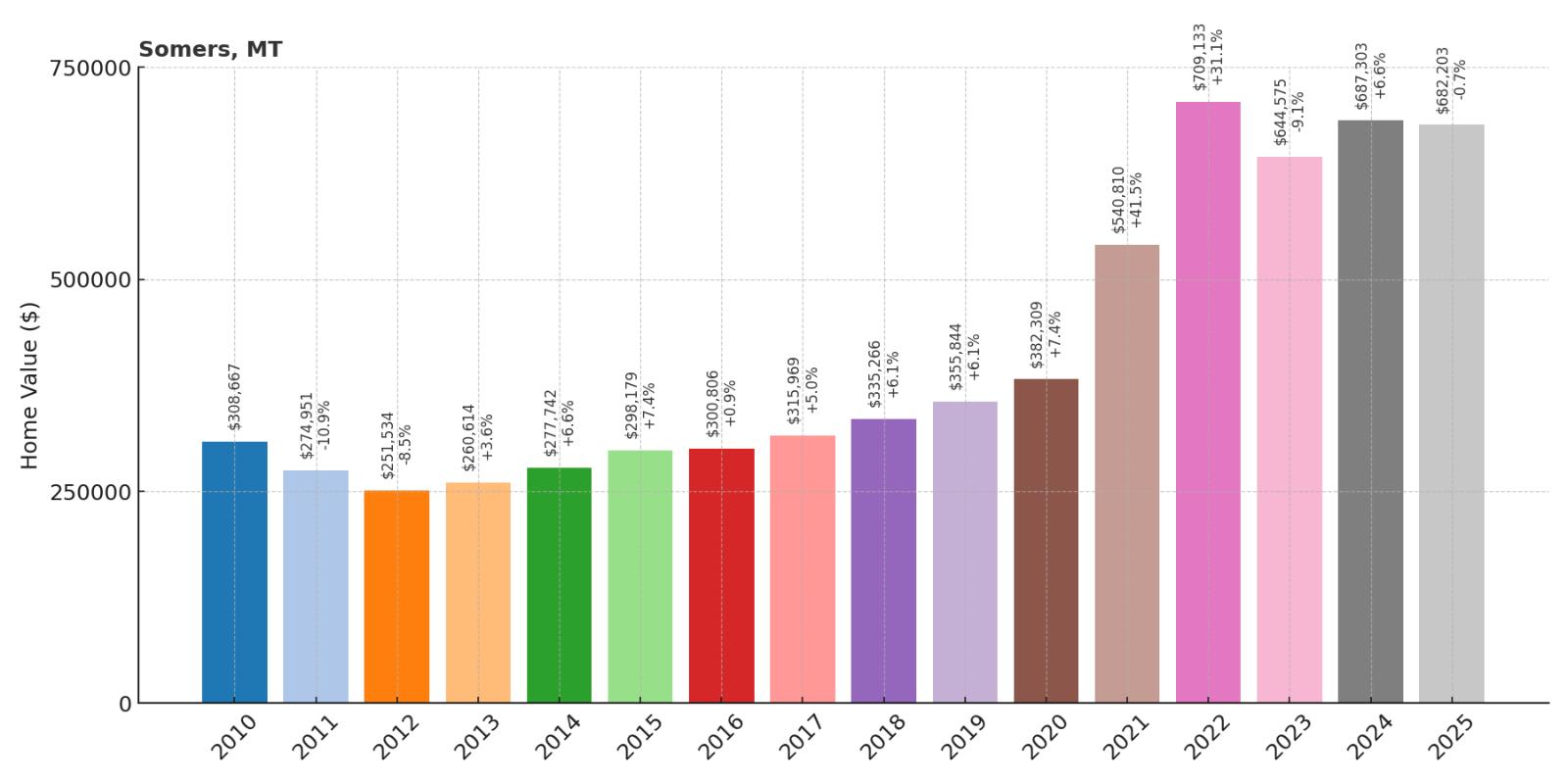
- 2010: $308,667
- 2011: $274,951
- 2012: $251,534
- 2013: $260,614
- 2014: $277,742
- 2015: $298,179
- 2016: $300,806
- 2017: $315,969
- 2018: $335,266
- 2019: $355,844
- 2020: $382,309
- 2021: $540,810
- 2022: $709,133
- 2023: $644,575
- 2024: $687,303
- 2025: $682,203
Somers has more than doubled since 2012 lows, reaching $682,000 in median home values by 2025. The Flathead Lake community recovered from early decade weakness and maintained steady growth before pandemic acceleration. Current values reflect stabilization in a range that maintains Somers’ position as an established lake community.
Why Somers?

Why are people willing to pay so much to live here? What’s special about it?
Somers sits at Flathead Lake’s northern end, providing lake access with proximity to both Kalispell and Whitefish for amenities and employment. The community offers established residential neighborhoods with lake views and water access at more moderate prices than prime lakefront locations. Properties range from lake-access homes to waterfront estates.
The area provides year-round recreation with summer lake activities and winter access to nearby ski areas and mountain recreation. Somers’ established community infrastructure and services appeal to both permanent residents and vacation homebuyers. The location offers Flathead Lake lifestyle with practical advantages for those needing proximity to larger communities.
How Somers Rose to Prominence
Somers developed as one of the early communities on Flathead Lake, serving both residential and commercial needs for the lake region. The area’s position at the lake’s northern end provided advantages for both transportation and recreation access. Early development focused on lake-related activities and summer tourism.
Growth accelerated as Flathead Lake gained recognition and property values throughout northwest Montana increased. The community’s established infrastructure and residential character provided stability that attracted permanent residents alongside vacation homebuyers. Recent appreciation reflects the premium placed on lake access and the scarcity of developable waterfront property.
3 Interesting Tidbits
1. Lake Position – Somers’ location at Flathead Lake’s northern end provides easy access to both lake recreation and nearby mountain activities.
2. Community Services – The area features established infrastructure and services that support both year-round residents and seasonal property owners.
3. Recreation Hub – Somers provides access to multiple recreational opportunities including lake activities, mountain recreation, and proximity to Glacier National Park.
18. Marion – 136% Home Price Increase Since 2010
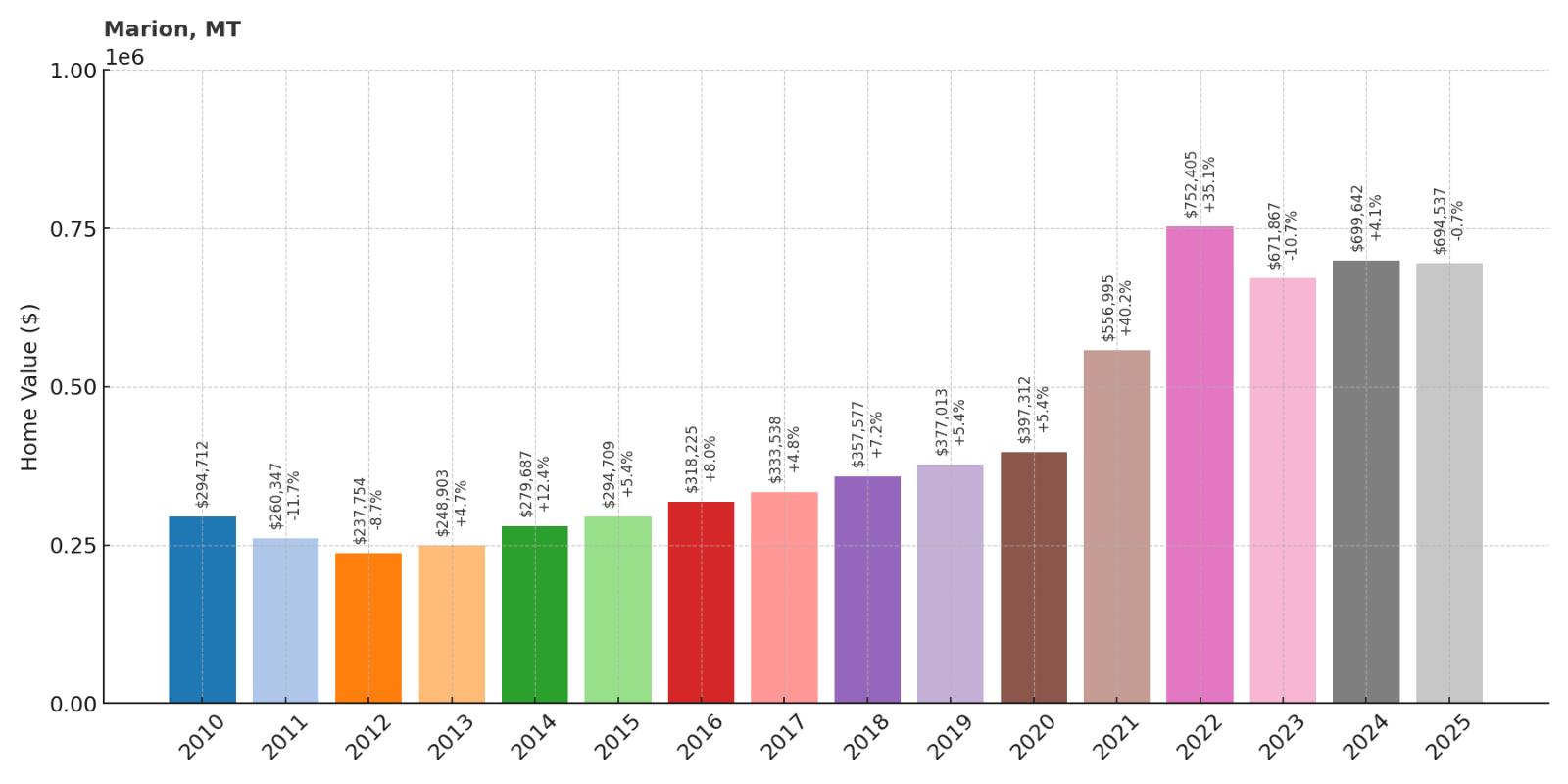
- 2010: $294,712
- 2011: $260,347
- 2012: $237,754
- 2013: $248,903
- 2014: $279,687
- 2015: $294,709
- 2016: $318,225
- 2017: $333,538
- 2018: $357,577
- 2019: $377,013
- 2020: $397,312
- 2021: $556,995
- 2022: $752,405
- 2023: $671,867
- 2024: $699,642
- 2025: $694,537
Marion has more than doubled since recovering from 2012 lows, reaching $695,000 in median home values by 2025. The Flathead County community showed steady recovery and growth through the 2010s before pandemic acceleration. Current values have stabilized around levels that reflect the area’s position in northwest Montana’s luxury market.
Why Marion?
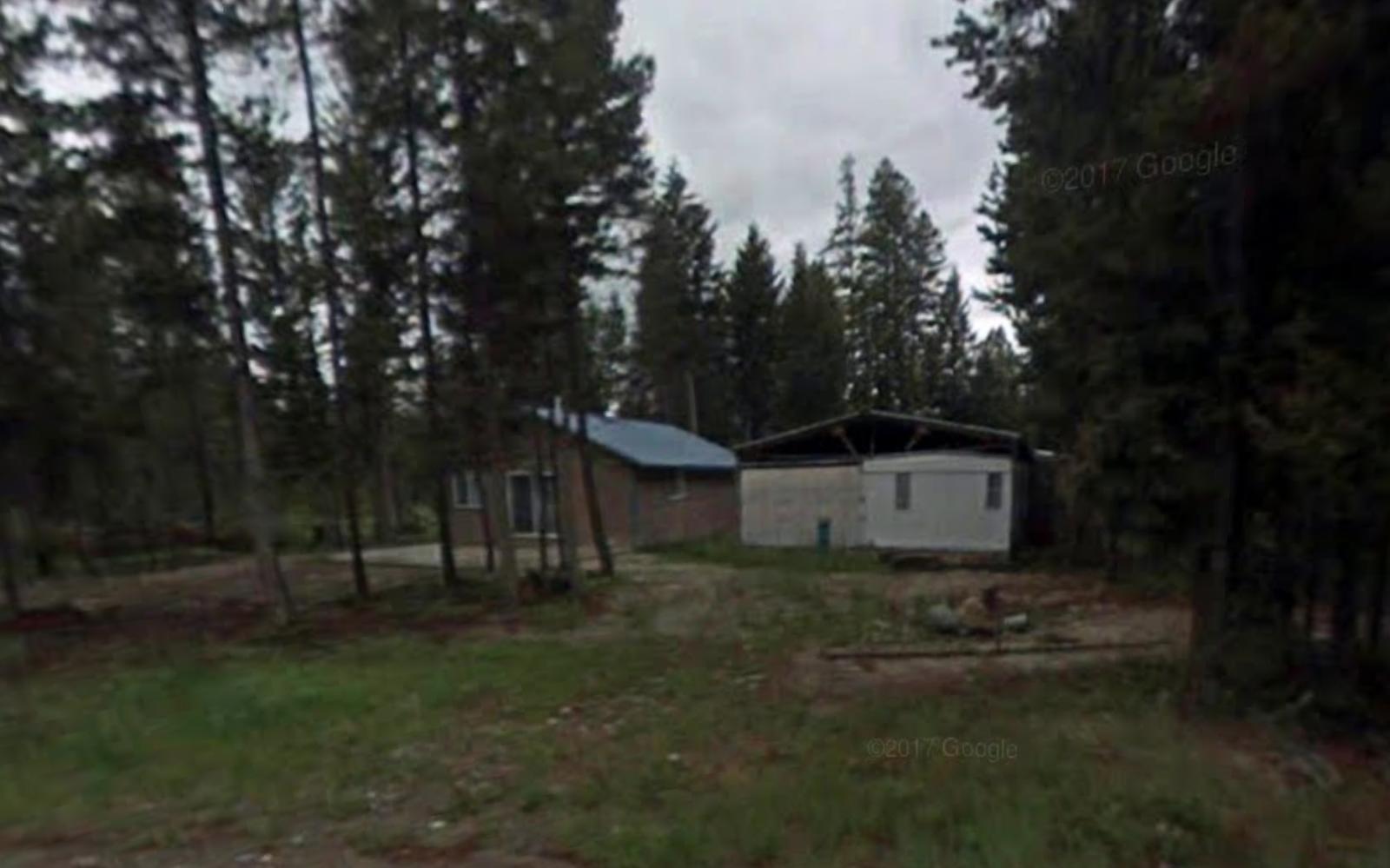
Why are people willing to pay so much to live here? What’s special about it?
Marion provides access to Flathead Lake region recreation while offering more space and value than prime lakefront locations. The area features rural properties with mountain views and proximity to outdoor activities including fishing, skiing, and hiking. Properties offer authentic Montana living with access to both lake and mountain recreation.
The community attracts buyers seeking northwest Montana lifestyle with larger properties and more privacy than resort areas provide. Marion’s location provides access to Flathead Lake activities while maintaining rural character and agricultural heritage. The area offers value within the region’s luxury market for those prioritizing space and authenticity over resort amenities.
How Marion Rose to Prominence
Marion developed as an agricultural community in Flathead County, serving farming and ranching operations in northwest Montana. The area’s economy centered on hay production and livestock operations that utilized valley land and mountain grazing areas. Railroad connections provided market access for agricultural products and supported early settlement.
Property appreciation followed broader trends in northwest Montana as recreational demand increased and luxury buyers discovered the region. The community’s rural character and larger properties attracted buyers seeking authentic Montana lifestyle. Recent growth reflects the premium placed on space and privacy within Montana’s competitive real estate market.
3 Interesting Tidbits
1. Rural Character – Marion maintains agricultural operations and rural atmosphere while providing access to Flathead region recreation and amenities.
2. Valley Location – The community sits in fertile valley land that continues to support farming and ranching alongside residential development.
3. Regional Access – Marion provides convenient access to multiple recreational areas including Flathead Lake, Glacier National Park, and mountain wilderness areas.
17. Huson – 192% Home Price Increase Since 2010

- 2010: $240,753
- 2011: $238,196
- 2012: $252,651
- 2013: $262,748
- 2014: $277,787
- 2015: $291,694
- 2016: $308,887
- 2017: $332,186
- 2018: $352,846
- 2019: $360,262
- 2020: $388,230
- 2021: $539,295
- 2022: $669,428
- 2023: $649,678
- 2024: $677,922
- 2025: $703,671
Huson has nearly tripled in value since 2010, reaching $704,000 in median home prices by 2025. The Missoula County community showed consistent growth throughout the 2010s before pandemic acceleration drove substantial gains. Recent years have maintained values around $700,000, reflecting the area’s appeal as a rural residential destination with urban access.
Why Huson?

Why are people willing to pay so much to live here? What’s special about it?
Huson offers rural lifestyle with convenient access to Missoula’s employment and amenities, attracting buyers seeking space and privacy without long commutes. The area features larger properties and mountain views while maintaining proximity to university culture and outdoor recreation opportunities. Properties provide the authentic Montana experience with modern conveniences and city access.
The community appeals to professionals and retirees who want rural living with urban proximity for work or cultural activities. Huson’s position in Missoula County provides access to both wilderness recreation and university town amenities. The combination of space, views, and accessibility creates value for buyers seeking the best of both rural and urban Montana living.
How Huson Rose to Prominence
Huson developed as a rural community serving the agricultural needs of the Missoula area, with properties focused on farming and ranching operations. The area remained primarily agricultural until growth pressure from Missoula created demand for residential properties outside city limits. Early development provided larger lots and rural character that appealed to buyers seeking space and privacy.
Property values increased as Missoula’s economy grew and professionals sought rural residential options within commuting distance. The University of Montana’s expansion and Missoula’s development as a regional center created employment opportunities that supported higher property values. Recent appreciation reflects broader Montana market trends and continued demand for rural properties with city access.
3 Interesting Tidbits
1. Commuter Community – Huson provides rural lifestyle while maintaining reasonable commute times to Missoula for employment and cultural activities.
2. Property Size – The area offers larger residential properties than urban areas, appealing to buyers seeking space for horses, gardens, and outdoor activities.
3. Mountain Views – Properties in Huson feature views of surrounding mountain ranges while maintaining valley floor location and convenience.
16. Kila – 145% Home Price Increase Since 2010
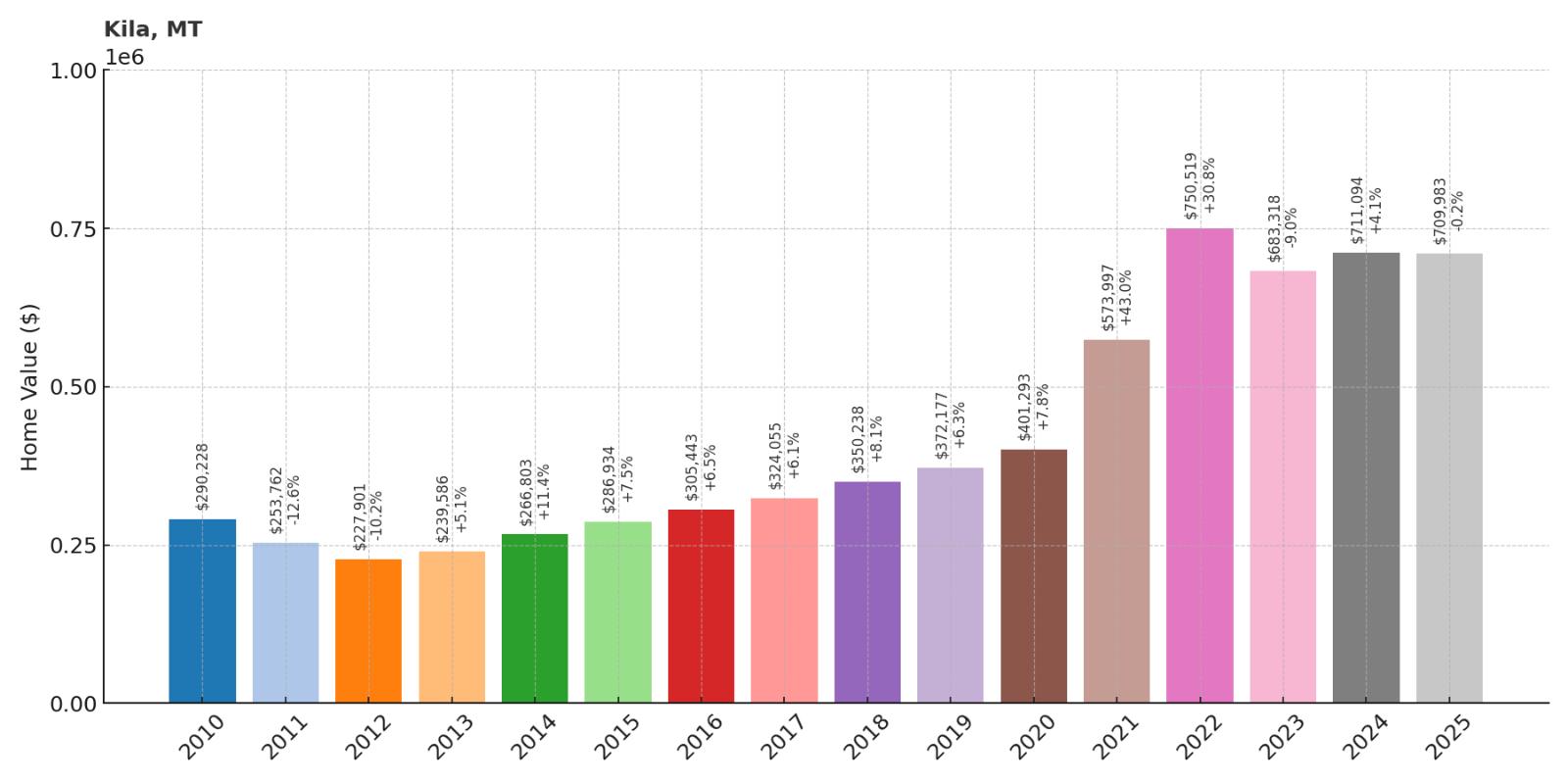
- 2010: $290,228
- 2011: $253,762
- 2012: $227,901
- 2013: $239,586
- 2014: $266,803
- 2015: $286,934
- 2016: $305,443
- 2017: $324,055
- 2018: $350,238
- 2019: $372,177
- 2020: $401,293
- 2021: $573,997
- 2022: $750,519
- 2023: $683,318
- 2024: $711,094
- 2025: $709,983
Kila has more than doubled since hitting lows in 2012, reaching $710,000 in median home values by 2025. The northwest Montana community recovered from early decade weakness and maintained steady growth before pandemic acceleration. Current values reflect stabilization around levels that establish Kila as a significant Flathead County market.
Why Kila?
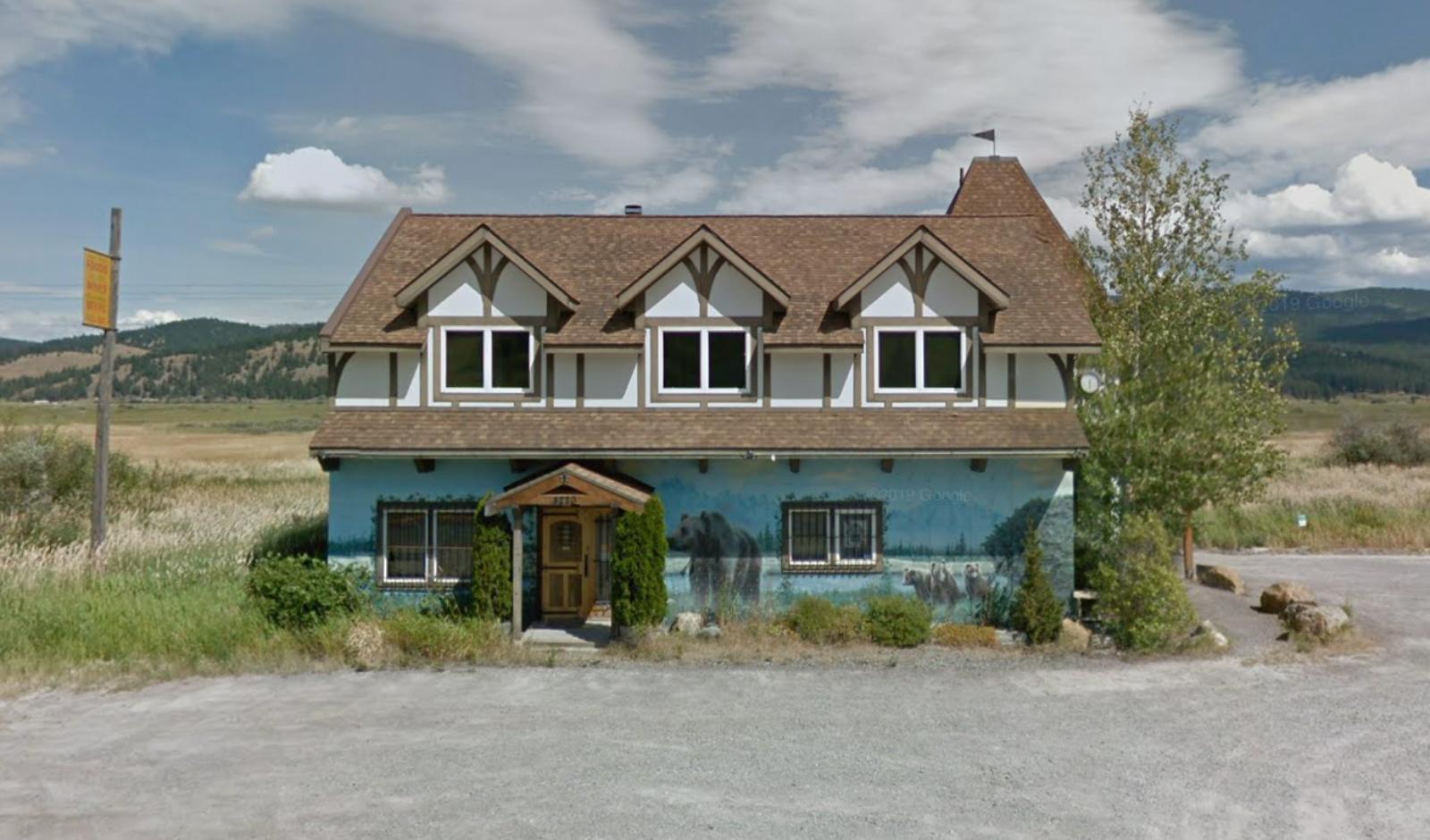
Why are people willing to pay so much to live here? What’s special about it?
Kila provides access to Flathead County’s recreational opportunities while maintaining a more rural and affordable character than lakefront communities. The area offers larger properties and mountain views with proximity to both Whitefish and Kalispell for amenities and services. Properties feature space and privacy that appeal to buyers seeking authentic Montana living.
The community attracts those wanting northwest Montana lifestyle without resort pricing or tourism pressures. Kila’s position provides access to Glacier National Park, Whitefish Mountain Resort, and Flathead Lake while offering more space and value than communities directly on the lake. The area maintains agricultural and rural character that appeals to buyers seeking traditional Montana living.
How Kila Rose to Prominence
Kila developed as an agricultural community in Flathead County, serving the farming and ranching operations of northwest Montana. The area’s economy centered on hay production and cattle operations that took advantage of fertile valley land and mountain grazing. Early settlement was supported by railroad connections that provided market access for agricultural products.
Property values increased as northwest Montana gained recognition as a recreational destination and luxury real estate market. The community’s rural character and larger properties attracted buyers seeking authentic Montana lifestyle with modern conveniences. Recent appreciation reflects broader trends affecting all Flathead County communities as demand for Montana properties has intensified.
3 Interesting Tidbits
1. Agricultural Roots – Kila maintains working farms and ranches that continue traditional agricultural operations alongside residential development.
2. Mountain Access – The community provides access to multiple mountain ranges for hiking, hunting, and outdoor recreation while maintaining valley floor location and amenities.
3. Balanced Living – Kila offers a balance between rural space and suburban conveniences, with proximity to both Kalispell and Whitefish for shopping and services.
15. Emigrant – 151% Home Price Increase Since 2013
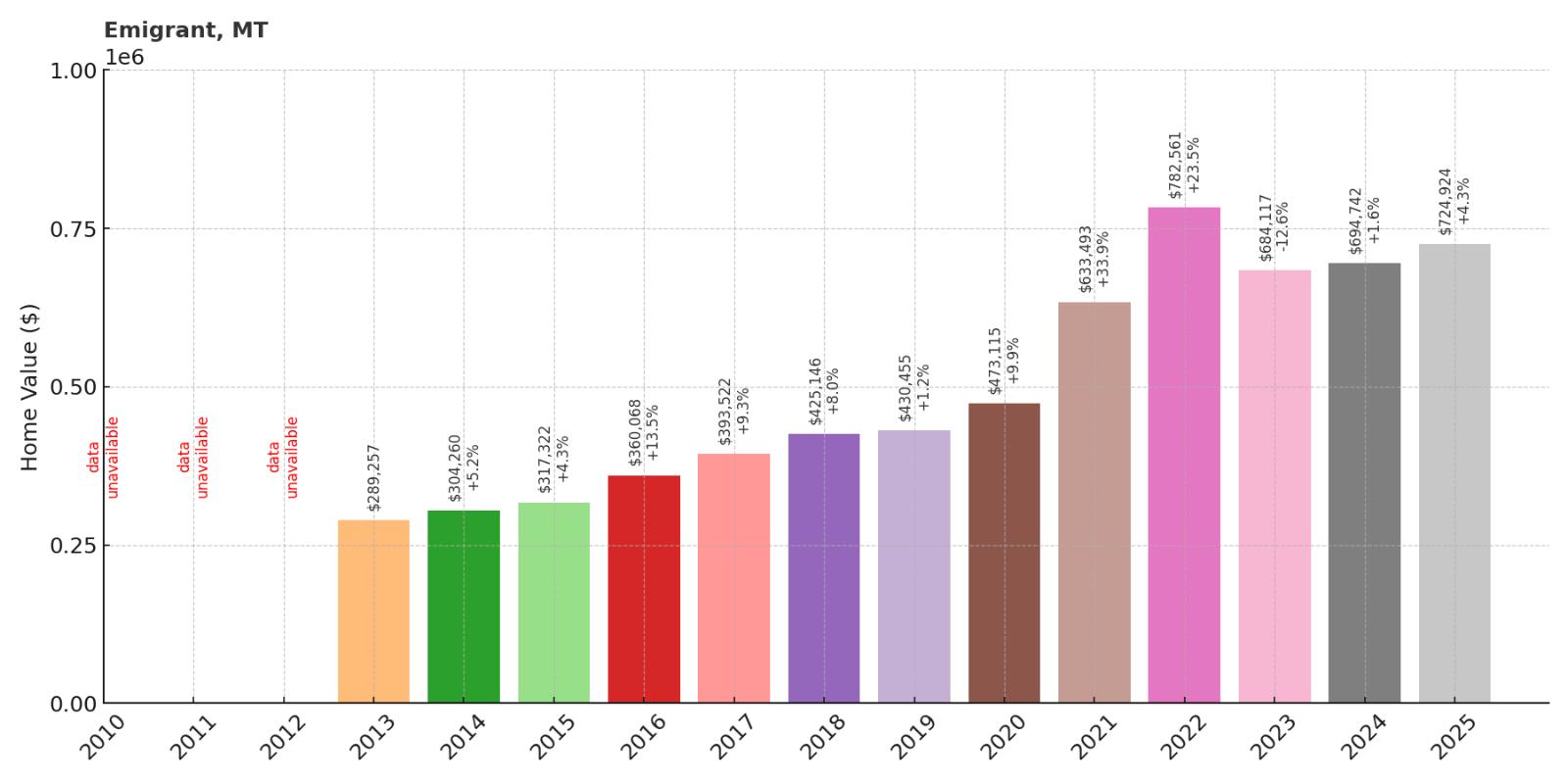
- 2010: N/A
- 2011: N/A
- 2012: N/A
- 2013: $289,257
- 2014: $304,260
- 2015: $317,322
- 2016: $360,068
- 2017: $393,522
- 2018: $425,146
- 2019: $430,455
- 2020: $473,115
- 2021: $633,493
- 2022: $782,561
- 2023: $684,117
- 2024: $694,742
- 2025: $724,924
Emigrant has more than doubled since 2013, with median home values reaching $725,000 by 2025. The Paradise Valley community experienced steady growth through 2020 before pandemic acceleration drove values substantially higher. Recent stabilization around $700,000 reflects the area’s established appeal as a recreational and residential destination.
Why Emigrant?

Why are people willing to pay so much to live here? What’s special about it?
Emigrant sits in Paradise Valley along the Yellowstone River, providing access to world-renowned fishing and mountain recreation between the Absaroka and Gallatin ranges. The community offers ranch properties and custom homes with river access and panoramic valley views. Properties feature the authentic Montana ranch lifestyle while maintaining proximity to Yellowstone National Park and modern amenities.
The area attracts buyers seeking privacy and outdoor recreation in one of Montana’s most scenic valleys. Emigrant provides access to blue-ribbon trout fishing, hunting, and hiking while offering larger properties than many resort areas. The combination of natural beauty, recreational access, and ranch heritage creates appeal for luxury buyers seeking authentic Montana living.
How Emigrant Rose to Prominence
Emigrant developed as a ranching community in Paradise Valley, taking advantage of the fertile land along the Yellowstone River and seasonal grazing in surrounding mountains. Early settlers were drawn by the combination of agricultural potential and natural beauty. The area remained primarily agricultural until recreational interest in the Yellowstone region increased.
The transformation to a luxury residential market followed the discovery of Paradise Valley by outdoor enthusiasts and celebrity buyers seeking privacy and recreation. The area’s fishing reputation and proximity to Yellowstone National Park attracted high-net-worth individuals. Recent development has focused on luxury properties that maintain the valley’s ranch character while providing modern amenities.
3 Interesting Tidbits
1. Paradise Valley – Emigrant sits in the heart of Paradise Valley, considered one of Montana’s most beautiful and photographed landscapes.
2. River Access – The Yellowstone River through the area provides some of the world’s best trout fishing, with public access points near the community.
3. Mountain Gateway – The community provides access to both the Absaroka-Beartooth Wilderness and Yellowstone National Park for hiking and backcountry recreation.
14. Bozeman – 180% Home Price Increase Since 2010
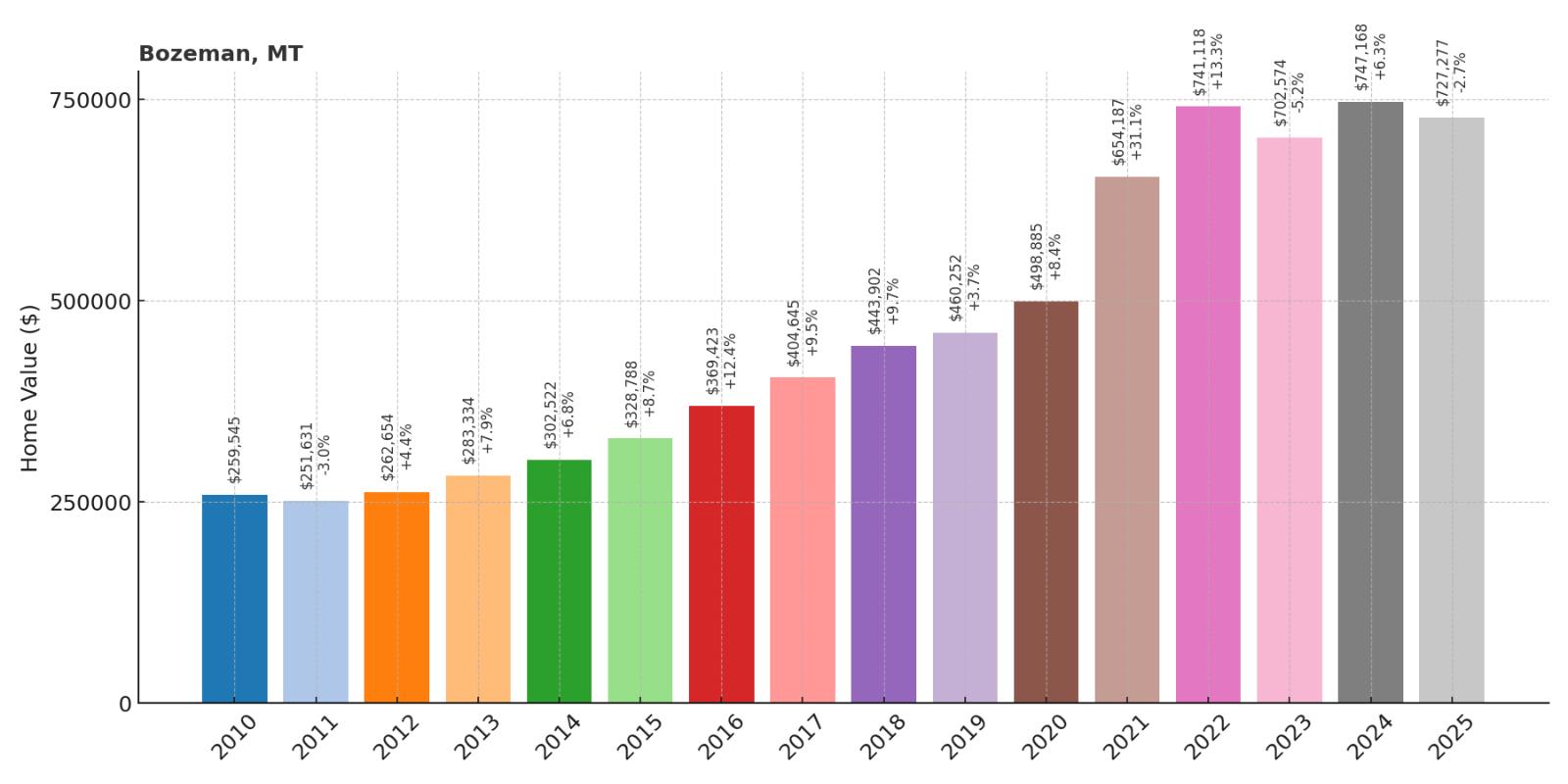
- 2010: $259,545
- 2011: $251,631
- 2012: $262,654
- 2013: $283,334
- 2014: $302,522
- 2015: $328,788
- 2016: $369,423
- 2017: $404,645
- 2018: $443,902
- 2019: $460,252
- 2020: $498,885
- 2021: $654,187
- 2022: $741,118
- 2023: $702,574
- 2024: $747,168
- 2025: $727,277
Bozeman has nearly tripled in value since 2010, reaching $727,000 in median home prices despite recent modest declines. Montana’s tech hub showed consistent growth throughout the 2010s before pandemic acceleration drove values above $700,000. The city’s position as both a university town and outdoor destination has sustained high property values.
Why Bozeman?

Why are people willing to pay so much to live here? What’s special about it?
Bozeman combines university culture with outdoor recreation and a growing tech sector, creating appeal for both young professionals and retirees. Montana State University provides cultural amenities and a educated workforce, while proximity to Yellowstone National Park and Big Sky Resort offers world-class outdoor access. The city features vibrant downtown areas with restaurants, galleries, and entertainment options that rival much larger cities.
Properties range from downtown condos to large ranch estates in surrounding Gallatin County, providing options across price ranges within the luxury market. Bozeman’s position as Montana’s tech hub attracts high-earning professionals, while the university connection brings stability and cultural amenities. The combination of employment opportunities, recreation access, and small-city charm justifies premium pricing for many buyers.
How Bozeman Rose to Prominence
Bozeman began as an agricultural center in the Gallatin Valley, founded in the 1860s along the Bozeman Trail route to Montana’s goldfields. Montana State University, established in 1893 as the state’s agricultural college, provided stability and growth throughout the 20th century. The combination of education, agriculture, and transportation made Bozeman the region’s commercial center.
Modern growth accelerated as outdoor recreation and technology sectors developed, attracting new residents and investment to the area. The city became Montana’s tech hub while maintaining its university character and outdoor appeal. Recent appreciation reflects Bozeman’s transformation into one of the Mountain West’s premier small cities, combining employment opportunities with lifestyle amenities.
3 Interesting Tidbits
1. University Anchor – Montana State University has grown to over 17,000 students, making it the first university in Montana to surpass that enrollment milestone.
2. Tech Growth – Bozeman has emerged as Montana’s technology center, attracting startups and established companies drawn by the educated workforce and quality of life.
3. Museum Trail – The city features the Museum of the Rockies with world-renowned dinosaur exhibits, including the largest collection of T. rex specimens and fossils.
13. Gardiner – 155% Home Price Increase Since 2013
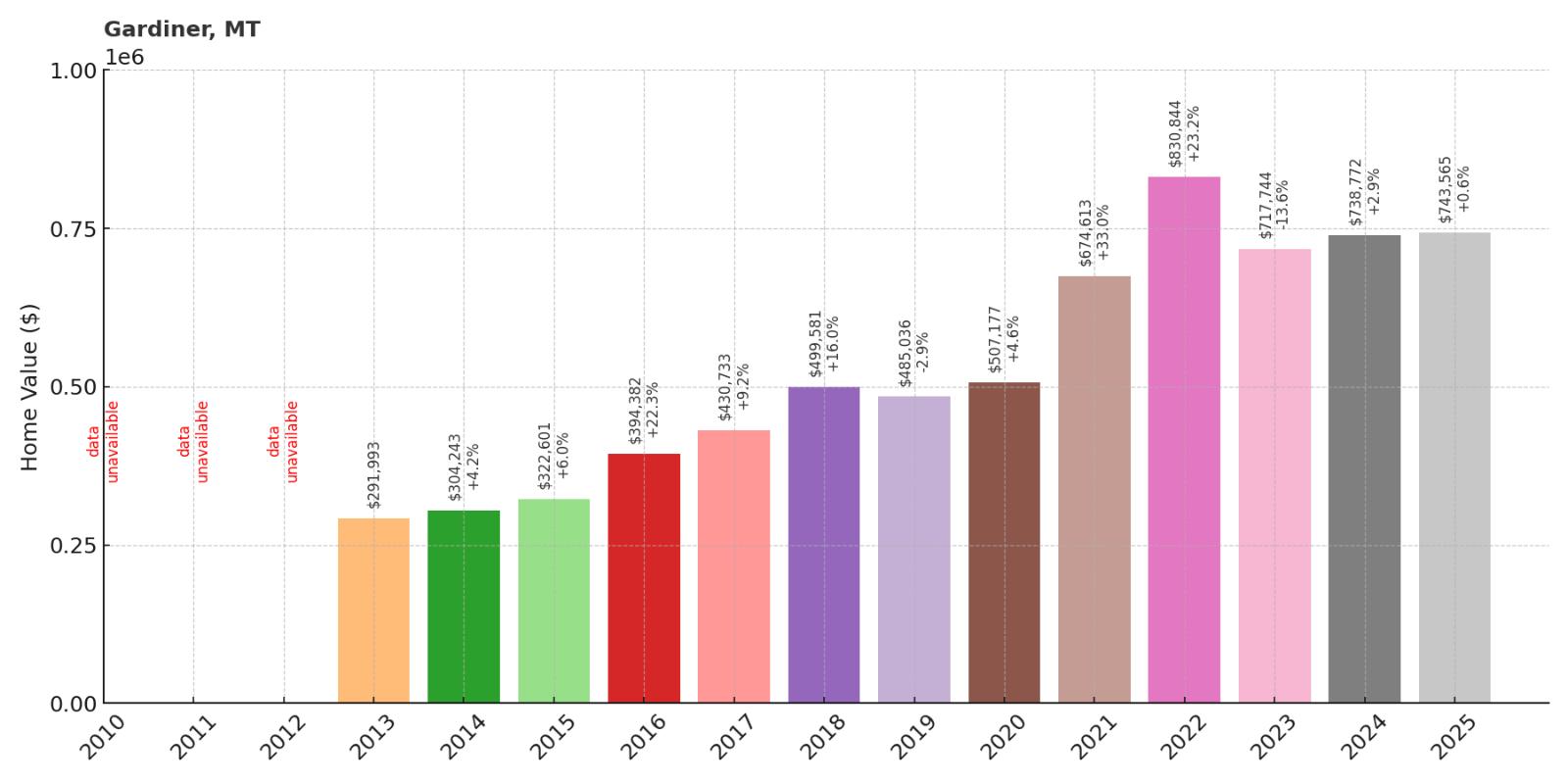
- 2010: N/A
- 2011: N/A
- 2012: N/A
- 2013: $291,993
- 2014: $304,243
- 2015: $322,601
- 2016: $394,382
- 2017: $430,733
- 2018: $499,581
- 2019: $485,036
- 2020: $507,177
- 2021: $674,613
- 2022: $830,844
- 2023: $717,744
- 2024: $738,772
- 2025: $743,565
Gardiner has experienced substantial appreciation, with values increasing 155% since 2013 to reach $744,000. The Yellowstone gateway community showed accelerating growth through 2018, with pandemic years bringing dramatic increases that peaked in 2022. Recent stabilization reflects the community’s established position as a year-round gateway to Yellowstone National Park.
Why Gardiner?

Why are people willing to pay so much to live here? What’s special about it?
Gardiner serves as Yellowstone National Park’s original and only year-round entrance, providing exclusive access to the park during winter months when other entrances close. The community sits along the Yellowstone River where it flows out of the park, offering world-class fishing and wildlife viewing opportunities. Properties feature mountain views and river access with direct park proximity.
The area appeals to buyers seeking authentic western living with unmatched park access and outdoor recreation. Gardiner’s year-round accessibility and established infrastructure make it attractive for both permanent residents and vacation homebuyers. The combination of park access, river recreation, and mountain setting creates unique value for outdoor enthusiasts and investors.
How Gardiner Rose to Prominence
Gardiner developed as the original gateway to Yellowstone National Park, established when the railroad brought the first tourists to the park’s north entrance in the late 1800s. The community grew around tourism services and park access, with early businesses catering to visitors exploring America’s first national park. The town’s position at the confluence of the Gardner and Yellowstone rivers provided natural advantages.
Modern Gardiner evolved as year-round park access became increasingly valuable and recreational real estate demand increased throughout the region. The community’s unique position as the only year-round entrance to Yellowstone created sustained demand for properties. Recent appreciation reflects both the scarcity of park-adjacent real estate and Montana’s broader luxury market growth.
3 Interesting Tidbits
1. Historic Gateway – Gardiner features the original Roosevelt Arch entrance to Yellowstone National Park, built in 1903 and inscribed “For the Benefit and Enjoyment of the People.”
2. Year-Round Access – Unlike other Yellowstone entrances that close in winter, Gardiner provides the only year-round vehicle access to the park’s interior.
3. Wildlife Viewing – The area around Gardiner offers some of North America’s best wildlife viewing, with elk herds wintering in the valley and wolves, bears, and bison frequently visible.
12. Silver Gate – 186% Home Price Increase Since 2013
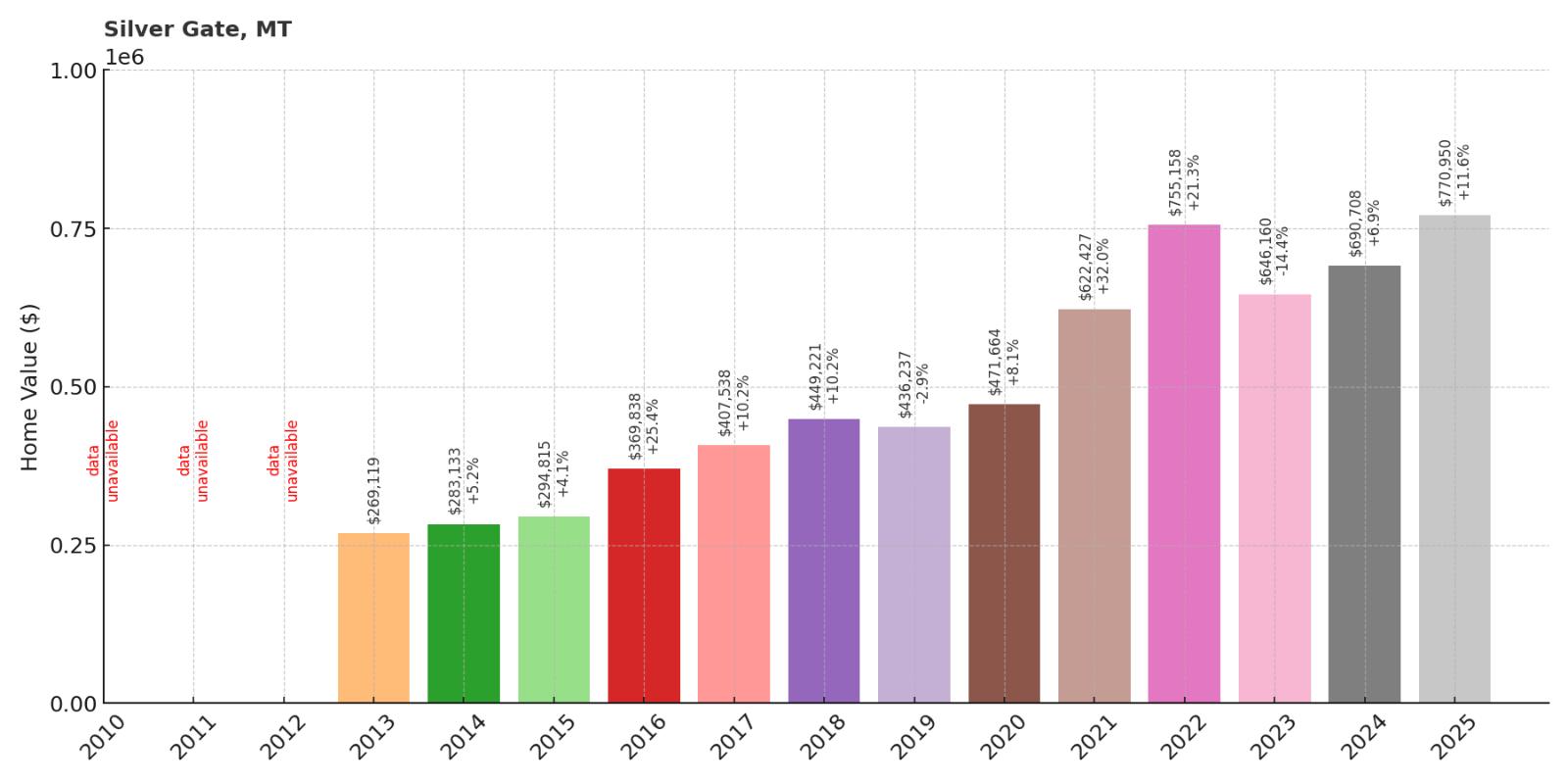
- 2010: N/A
- 2011: N/A
- 2012: N/A
- 2013: $269,119
- 2014: $283,133
- 2015: $294,815
- 2016: $369,838
- 2017: $407,538
- 2018: $449,221
- 2019: $436,237
- 2020: $471,664
- 2021: $622,427
- 2022: $755,158
- 2023: $646,160
- 2024: $690,708
- 2025: $770,950
Silver Gate has nearly tripled in value since 2013, reaching $771,000 in median home prices by 2025. The Yellowstone gateway community experienced steady appreciation through 2018, followed by volatility during the pandemic years. Current values represent a rebound from 2023 lows, reflecting renewed interest in properties near Yellowstone’s northeast entrance
Why Silver Gate?
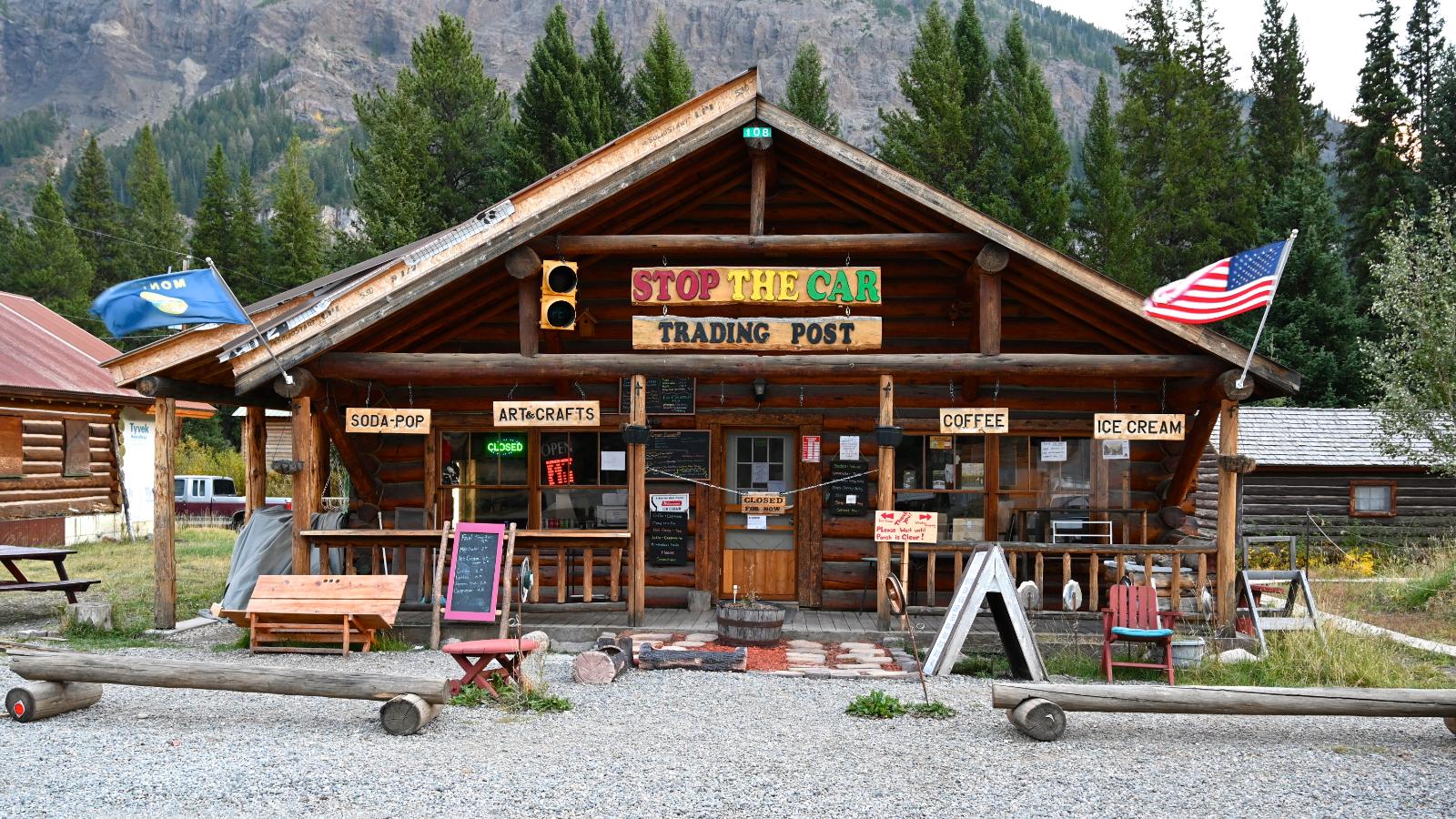
Why are people willing to pay so much to live here? What’s special about it?
Silver Gate sits at Yellowstone National Park’s northeast entrance, providing year-round access to the park’s remote Lamar Valley wildlife viewing area. The tiny community offers an exclusive gateway experience with only a handful of properties available, creating scarcity that drives values. Properties provide direct access to some of Yellowstone’s best wildlife viewing and fishing opportunities.
The area attracts buyers seeking the ultimate Yellowstone experience with properties that function as private base camps for park exploration. Silver Gate’s remote location and small size appeal to those wanting privacy and direct park access without resort development. The community offers authentic mountain living with unparalleled access to one of America’s premier national parks.
How Silver Gate Rose to Prominence
Silver Gate developed as a small gateway community serving visitors to Yellowstone’s northeast entrance, one of the park’s most remote and scenic access points. The area remained undeveloped compared to other Yellowstone gateways due to its remote location and seasonal accessibility challenges. Early buildings served basic needs for park visitors and seasonal residents.
Property values increased as Yellowstone’s northeast entrance gained recognition for wildlife viewing and fishing access. The Lamar Valley’s reputation as “America’s Serengeti” brought increased visitation and interest in nearby properties. Recent appreciation reflects growing demand for exclusive access to Yellowstone’s remote areas and the scarcity of available properties in gateway communities.
3 Interesting Tidbits
1. Park Gateway – Silver Gate is one of the smallest communities serving as a Yellowstone National Park entrance, creating an exclusive and intimate gateway experience.
2. Wildlife Central – The location provides direct access to Lamar Valley, known as “America’s Serengeti” for its abundant wildlife including wolves, bison, and bears.
3. Seasonal Access – The northeast entrance road through Silver Gate is one of the few Yellowstone routes that remains open year-round, though winter conditions can be challenging.
11. Elmo – 129% Home Price Increase Since 2013
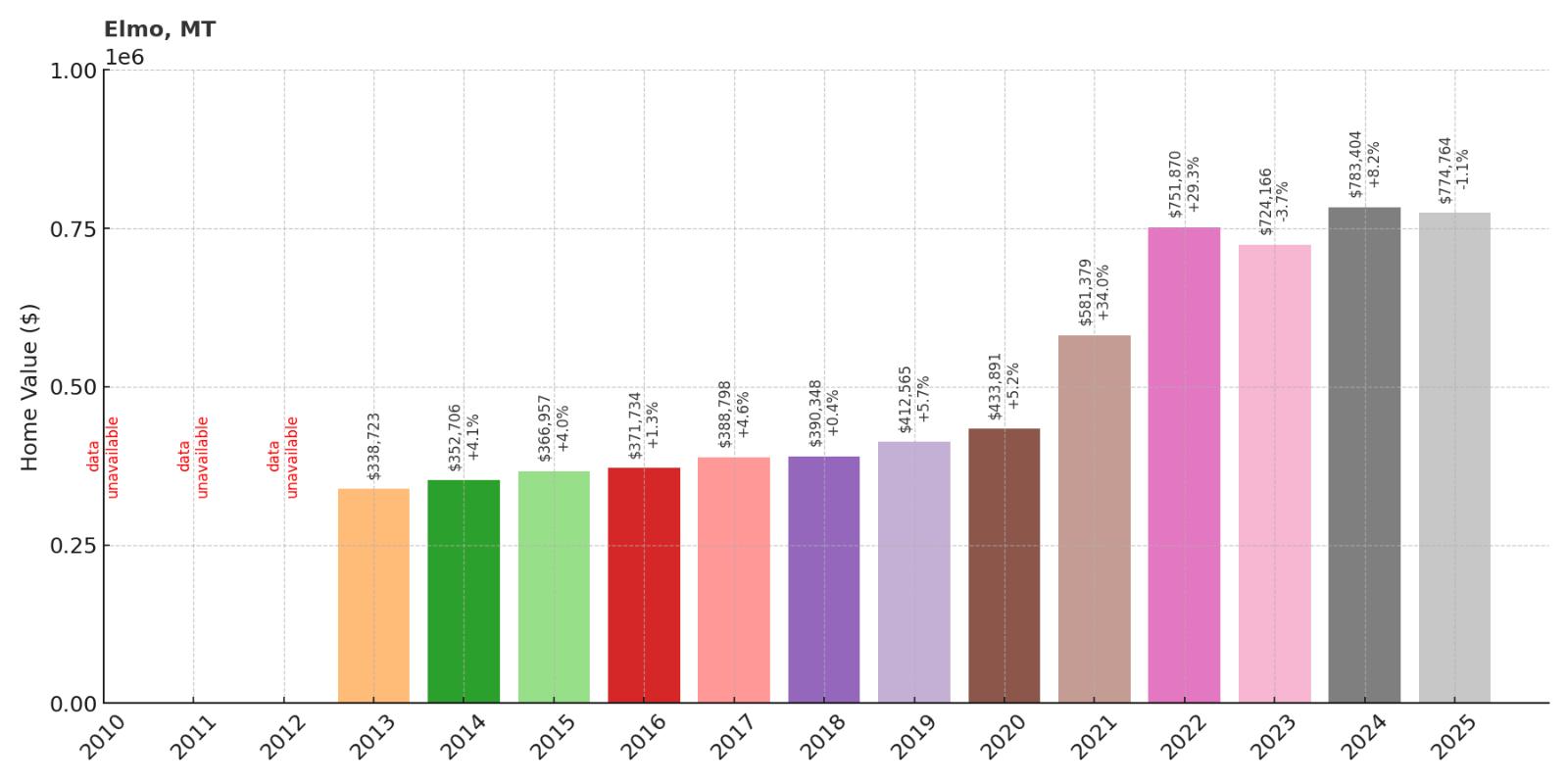
- 2010: N/A
- 2011: N/A
- 2012: N/A
- 2013: $338,723
- 2014: $352,706
- 2015: $366,957
- 2016: $371,734
- 2017: $388,798
- 2018: $390,348
- 2019: $412,565
- 2020: $433,891
- 2021: $581,379
- 2022: $751,870
- 2023: $724,166
- 2024: $783,404
- 2025: $774,764
Elmo has more than doubled since 2013, with median home values reaching $775,000 by 2025. The Flathead Lake community showed modest but consistent growth through 2020 before pandemic demand drove substantial appreciation. Recent years have seen values stabilize around current levels, reflecting sustained demand for lakefront and lake-access properties.
Why Elmo?

Why are people willing to pay so much to live here? What’s special about it?
Elmo sits on Flathead Lake’s western shore, providing access to some of the lake’s most scenic and protected waters. The small community offers intimate lakefront living with properties that feature direct water access and mountain views across the lake. The area maintains a quiet, residential character that appeals to buyers seeking privacy and natural beauty.
Properties in Elmo benefit from the community’s position away from major tourist areas while maintaining lake access and recreational opportunities. The location offers both permanent residence options and vacation home potential, with many properties featuring private docks and waterfront amenities. The combination of lake access and mountain setting creates appeal for outdoor enthusiasts and luxury homebuyers.
How Elmo Rose to Prominence
Elmo developed as a small lakeside community serving the recreational and residential needs of Flathead Lake’s western shore. The area remained primarily local and agricultural until the broader growth of Montana’s recreational real estate market. Early development focused on summer cabins and vacation properties that took advantage of the lake setting and natural beauty.
The transition to higher property values followed the general appreciation of Flathead Lake real estate as demand increased for lakefront properties. The community’s small size and residential character attracted buyers seeking privacy and direct lake access. Recent growth reflects the premium placed on waterfront properties throughout the Flathead Lake region.
3 Interesting Tidbits
1. Lake Position – Elmo’s location on Flathead Lake’s western shore provides protection from prevailing winds while maintaining open water access for recreation.
2. Community Size – The small size of Elmo creates an intimate community feel while providing direct access to one of the West’s largest natural lakes.
3. Mountain Backdrop – Properties feature views across Flathead Lake to the Mission Mountains, creating dramatic scenery that changes with seasons and weather conditions.
10. Bigfork – 132% Home Price Increase Since 2010

- 2010: $335,289
- 2011: $304,107
- 2012: $281,027
- 2013: $293,614
- 2014: $309,991
- 2015: $327,683
- 2016: $341,580
- 2017: $352,870
- 2018: $383,442
- 2019: $400,486
- 2020: $423,265
- 2021: $611,291
- 2022: $815,383
- 2023: $739,615
- 2024: $775,086
- 2025: $776,807
Bigfork has more than doubled since its 2012 low point, reaching $777,000 in median home values by 2025. The Flathead Lake community showed steady recovery and growth through the 2010s before pandemic acceleration drove values above $800,000. Current pricing reflects stabilization around levels that maintain Bigfork’s position as a premier northwest Montana destination.
Why Bigfork?

Why are people willing to pay so much to live here? What’s special about it?
Bigfork combines small-town charm with sophisticated amenities, featuring art galleries, fine dining, and cultural events that rival larger cities. The community sits at the northeast end of Flathead Lake where the Swan River enters the lake, providing both water access and river recreation. Properties include both lakefront estates and homes with mountain views that overlook the Flathead Valley.
The area offers year-round recreation with summer lake activities and winter access to nearby ski areas and cross-country trails. Bigfork’s reputation as an arts community attracts cultural enthusiasts, while the natural setting provides outdoor recreation opportunities. The combination of cultural amenities and natural beauty creates unique appeal for luxury homebuyers.
How Bigfork Rose to Prominence
Bigfork began as a logging and mill town at the confluence of the Swan River and Flathead Lake, taking advantage of timber resources and water transportation. The area’s sawmills and lumber operations supported early development, with the natural harbor providing access to markets around the lake. Early residents were drawn by employment opportunities and the area’s natural beauty.
The transformation to a resort and arts community began as logging declined and tourism increased throughout northwest Montana. Bigfork developed its reputation as a cultural destination while maintaining its lakefront appeal and outdoor recreation access. The community evolved into a sophisticated small town that attracts both permanent residents and vacation homebuyers seeking luxury amenities with natural beauty.
3 Interesting Tidbits
1. Arts Hub – Bigfork features the renowned Bigfork Summer Playhouse and numerous art galleries, making it northwest Montana’s cultural center.
2. Swan River – The confluence of the Swan River and Flathead Lake creates unique fishing and boating opportunities, with both lake and river species available to anglers.
3. Cherry Festival – Bigfork hosts an annual cherry festival celebrating the area’s fruit orchards, which still operate around the lakefront community.
9. Lakeside – 101% Home Price Increase Since 2010
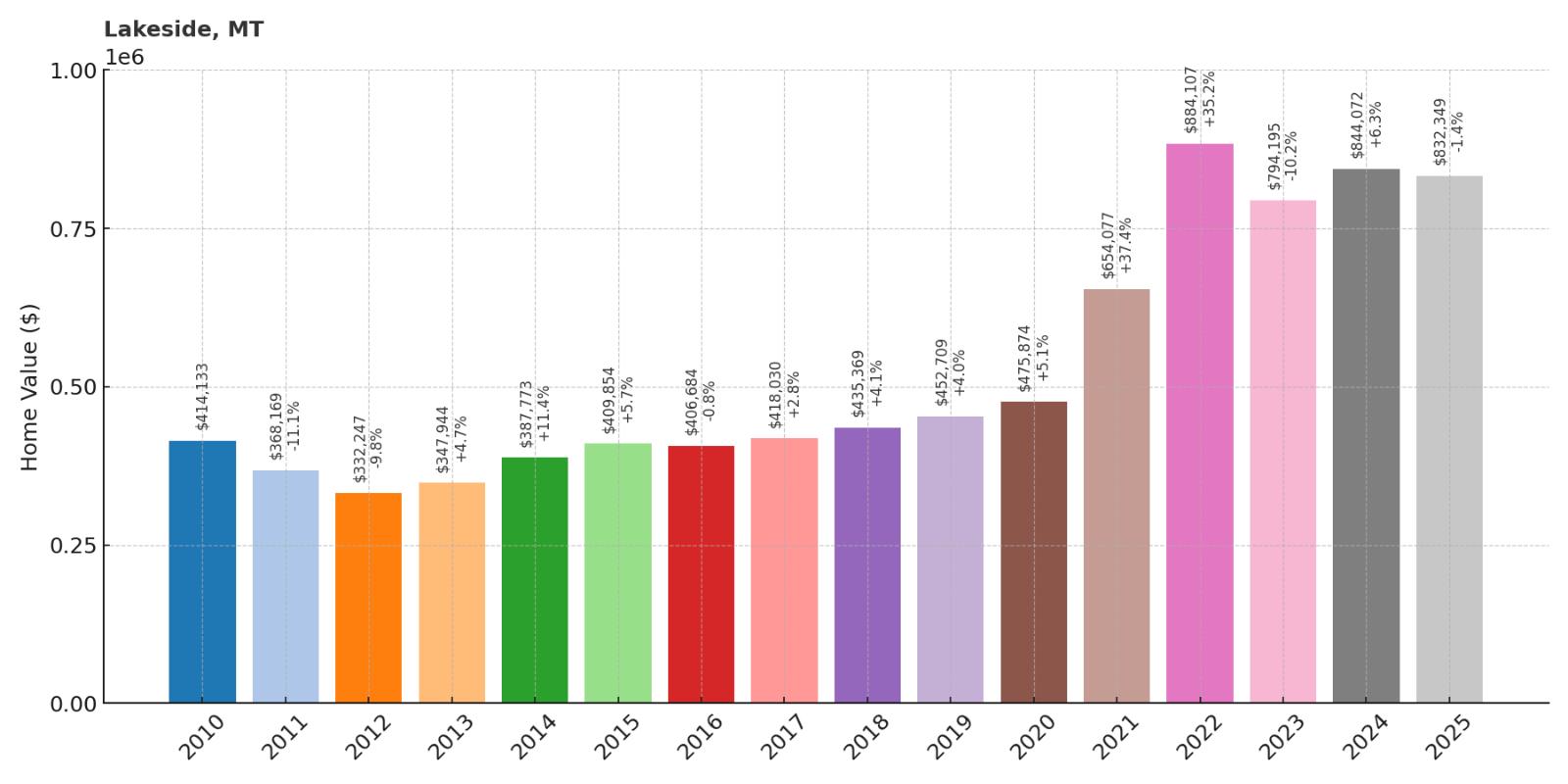
- 2010: $414,133
- 2011: $368,169
- 2012: $332,247
- 2013: $347,944
- 2014: $387,773
- 2015: $409,854
- 2016: $406,684
- 2017: $418,030
- 2018: $435,369
- 2019: $452,709
- 2020: $475,874
- 2021: $654,077
- 2022: $884,107
- 2023: $794,195
- 2024: $844,072
- 2025: $832,349
Lakeside has doubled in value since 2010, reaching $832,000 in median home prices despite early decade volatility. The Flathead Lake community recovered from 2012 lows and maintained steady growth through 2020. Pandemic years brought substantial appreciation that peaked in 2022, with current values stabilizing around $830,000.
Why Lakeside?

Why are people willing to pay so much to live here? What’s special about it?
Lakeside provides direct access to Flathead Lake’s western shore with established residential neighborhoods and lake amenities. The community offers a mix of waterfront properties and homes with lake access, providing options for different budgets within the luxury market. Year-round residents enjoy both summer water activities and winter recreation in nearby mountains.
The area combines lake lifestyle with small-town community feel, attracting buyers who want water access without resort development pressures. Properties range from lakefront estates to homes with shared lake access, all benefiting from Flathead Lake’s reputation for clean water and recreational opportunities. The location provides easy access to both Kalispell and Whitefish for additional amenities.
How Lakeside Rose to Prominence
Lakeside developed as one of the early resort communities on Flathead Lake, with tourism and recreation forming the foundation of the local economy. The area attracted summer visitors who built cabins and vacation homes along the lake’s western shore. Early development focused on providing access to the lake’s recreational opportunities while maintaining the natural setting.
Growth accelerated as Flathead Lake gained recognition as a premier recreational destination and property values throughout northwest Montana increased. The community’s established infrastructure and residential neighborhoods provided stability that attracted both permanent residents and vacation homebuyers. Recent appreciation reflects the broader luxury market trends affecting all Flathead Lake communities.
3 Interesting Tidbits
1. Lake Community – Lakeside is one of the established year-round communities on Flathead Lake, providing local services and amenities for both residents and visitors.
2. Water Access – The community features multiple public and private access points to Flathead Lake, making water activities accessible to residents throughout the area.
3. Mountain Views – Properties in Lakeside offer views across Flathead Lake to the Mission Mountains, creating dramatic vistas that change with seasonal conditions and lighting.
8. Garrison – 116% Home Price Increase Since 2016

- 2010: N/A
- 2011: N/A
- 2012: N/A
- 2013: N/A
- 2014: N/A
- 2015: N/A
- 2016: $386,224
- 2017: $405,082
- 2018: $414,039
- 2019: $407,594
- 2020: $423,111
- 2021: $578,245
- 2022: $715,602
- 2023: $682,181
- 2024: $762,448
- 2025: $833,392
Garrison has more than doubled since 2016, reaching $833,000 in median home values by 2025. The community showed steady but modest growth through 2020 before pandemic demand accelerated appreciation. Recent years have brought continued gains, with 2025 values representing the highest levels on record for this Powell County community.
Why Garrison?

Why are people willing to pay so much to live here? What’s special about it?
Garrison offers authentic Montana ranch country living with large properties and mountain views in Powell County. The area provides access to outdoor recreation including hunting, fishing, and hiking while maintaining the rural character that many buyers seek. Properties feature expansive acreage and privacy that appeals to those wanting space and solitude.
The community attracts buyers seeking traditional Montana lifestyle away from resort development and tourism. Ranch properties offer working agricultural operations or recreational estates with mountain access and wildlife viewing opportunities. The area’s location provides access to both Helena and Missoula while maintaining rural character and authentic Montana living.
How Garrison Rose to Prominence
Garrison developed as a small agricultural and railroad community in Powell County, serving the ranching operations of the Deer Lodge Valley. The area’s economy centered on cattle ranching and supporting services for the agricultural community. Early settlement was drawn by the combination of grazing land, water access, and transportation connections.
The transition to higher property values reflects broader trends in Montana real estate as buyers sought authentic ranch properties away from resort areas. The community’s rural character and large properties attracted buyers looking for traditional Montana lifestyle with modern amenities. Recent appreciation reflects increased demand for ranch and recreational properties throughout the state.
3 Interesting Tidbits
1. Ranch Heritage – Garrison maintains its agricultural roots with working cattle ranches that continue traditional Montana ranching operations alongside residential development.
2. Valley Setting – The community sits in the scenic Deer Lodge Valley, surrounded by mountain ranges that provide dramatic views and recreational access.
3. Wildlife Access – The area offers excellent hunting and wildlife viewing opportunities, with abundant deer, elk, and other native species in the surrounding mountains and valleys.
7. Whitefish – 166% Home Price Increase Since 2010
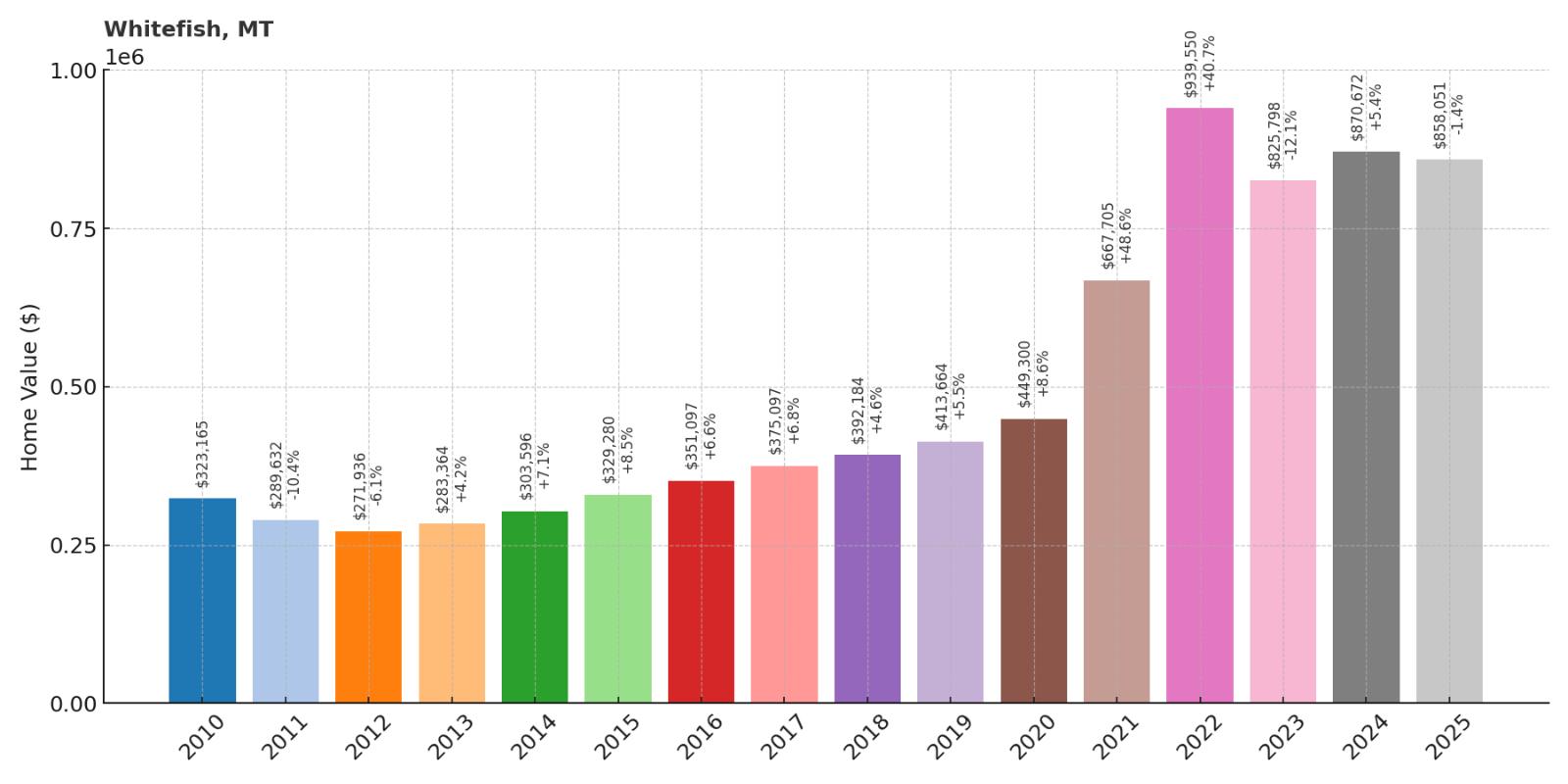
- 2010: $323,165
- 2011: $289,632
- 2012: $271,936
- 2013: $283,364
- 2014: $303,596
- 2015: $329,280
- 2016: $351,097
- 2017: $375,097
- 2018: $392,184
- 2019: $413,664
- 2020: $449,300
- 2021: $667,705
- 2022: $939,550
- 2023: $825,798
- 2024: $870,672
- 2025: $858,051
Whitefish has experienced significant appreciation, with median home values rising 166% since 2010 to reach $858,000. The ski resort town showed recovery from early 2010s lows before steady growth through the decade. Pandemic years brought dramatic increases that peaked in 2022, with current values stabilizing in a range that reflects strong underlying demand.
Why Whitefish?
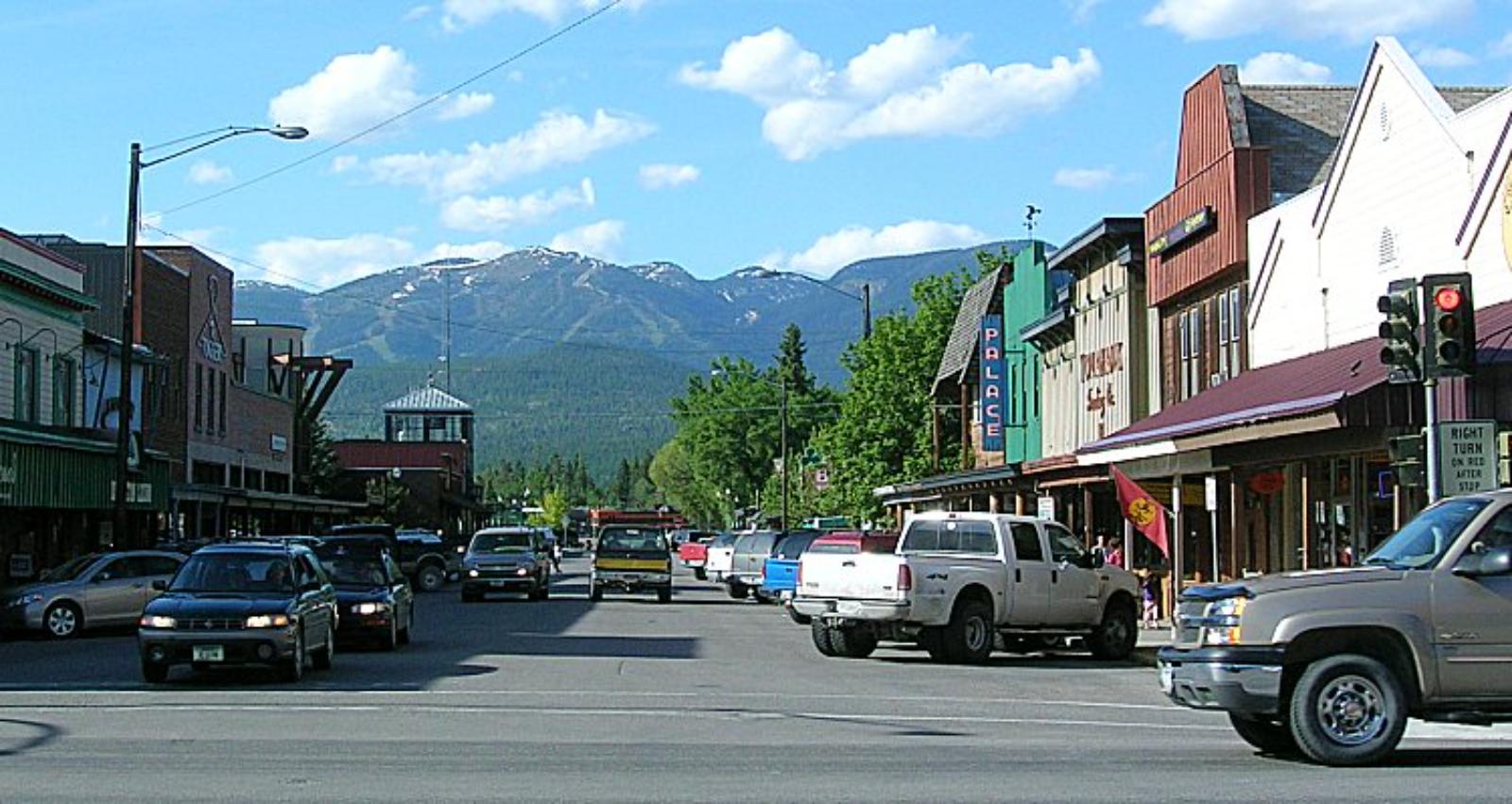
Why are people willing to pay so much to live here? What’s special about it?
Whitefish is a trendy, resort-style town with a mix of tourists and locals, known for its lively, eclectic charm, boutique shopping, and thriving dining scene. Whitefish Mountain Resort provides world-class skiing and snowboarding in winter, plus mountain biking and hiking in summer, while Whitefish Lake offers boating, fishing, and paddleboarding opportunities. The combination of year-round recreation and sophisticated amenities attracts both residents and visitors.
Properties include luxury cabins located next to the Whitefish Lake Golf Course, less than a mile from downtown and walking distance to lake and river access. The area offers everything from downtown condos to lakefront estates and ski-in, ski-out properties. Whitefish Lake Golf Course provides NW Montana’s only 36-hole course just steps from many properties.
How Whitefish Rose to Prominence
Whitefish began as a railroad town in the early 1900s, serving as a division point for the Great Northern Railway. The community’s position on Whitefish Lake and proximity to mountain recreation created early tourism interest, but major development waited until the establishment of Whitefish Mountain Resort in the 1940s. The ski area’s growth brought winter visitors who gradually discovered the area’s year-round appeal.
Modern Whitefish emerged as skiing gained popularity and the town developed into a full-service resort destination. The area evolved from a simple ski town to a year-round recreation hub with sophisticated dining, shopping, and cultural amenities. Recent development has focused on luxury properties that capture lake and mountain views while maintaining walkable access to downtown amenities.
3 Interesting Tidbits
1. Railroad Heritage – Whitefish maintains its historic Railway District in downtown, with the restored train depot serving as a reminder of the town’s transportation origins.
2. Cultural Scene – Whitefish is recognized as a mecca of arts and culture, featuring theater, music, film festivals, art galleries, and historic museums.
3. Lake Access – Whitefish Lake covers over 3,200 acres and offers some of northwest Montana’s best lake recreation, with crystal-clear waters reflecting the surrounding mountain peaks.
6. Cameron – 126% Home Price Increase Since 2016
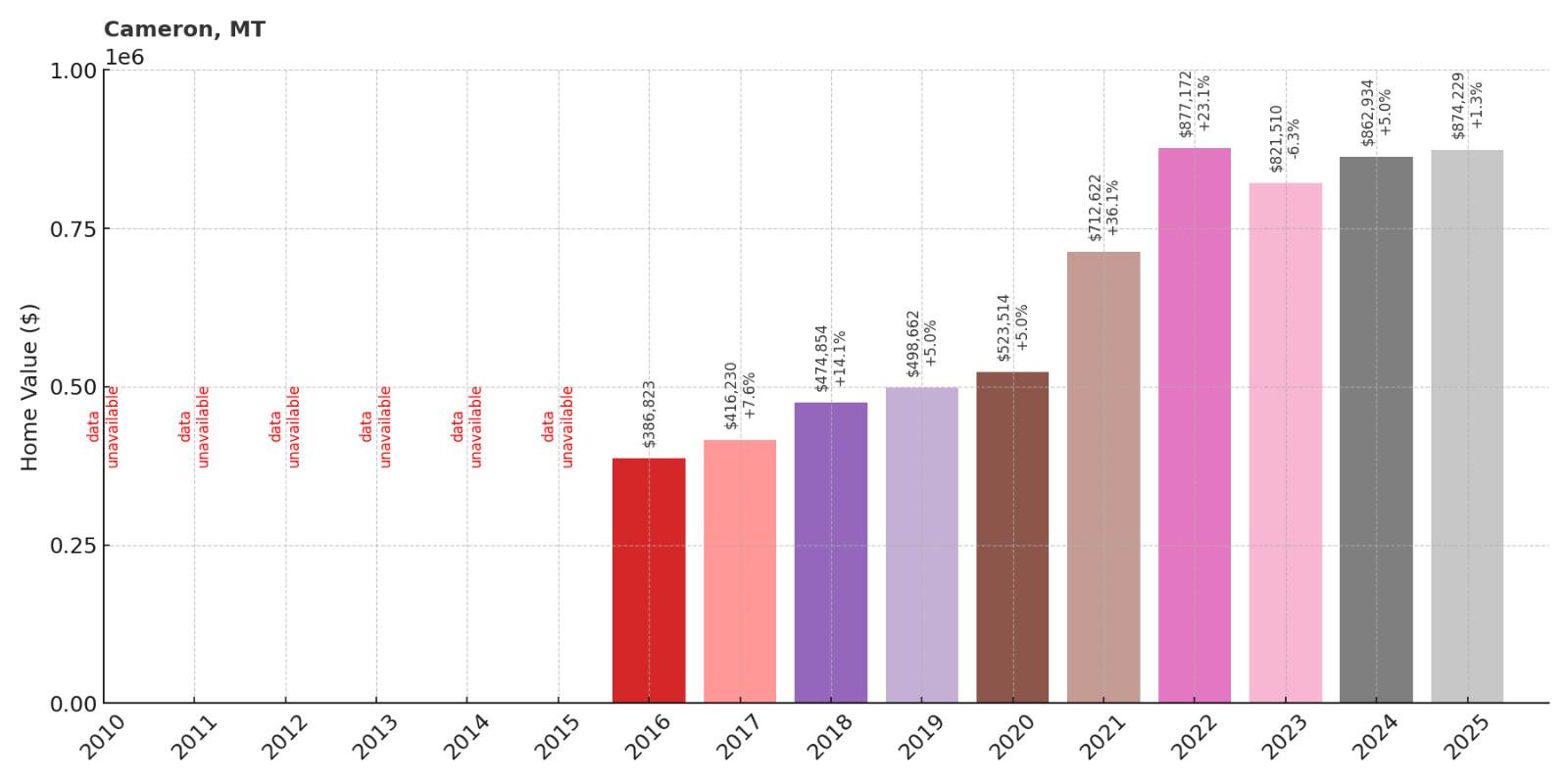
- 2010: N/A
- 2011: N/A
- 2012: N/A
- 2013: N/A
- 2014: N/A
- 2015: N/A
- 2016: $386,823
- 2017: $416,230
- 2018: $474,854
- 2019: $498,662
- 2020: $523,514
- 2021: $712,622
- 2022: $877,172
- 2023: $821,510
- 2024: $862,934
- 2025: $874,229
Cameron has more than doubled since 2016, reaching $874,000 in median home values by 2025. The Madison River valley community showed consistent growth before pandemic acceleration drove values above $800,000. Current pricing reflects the area’s appeal as a fishing and recreational destination with Yellowstone proximity.
Why Cameron?

Why are people willing to pay so much to live here? What’s special about it?
Cameron sits in the heart of the Madison River valley, providing access to some of Montana’s most famous trout fishing waters. The location offers large ranch properties with river access, mountain views, and proximity to both Yellowstone National Park and Big Sky Resort. Properties feature expansive acreage that allows for privacy while maintaining recreational access.
The community attracts buyers seeking authentic Montana ranch lifestyle combined with world-class outdoor recreation. Madison River fishing draws enthusiasts from around the globe, while the area’s position between major recreational destinations provides year-round activity options. Properties offer the space and setting for both working ranches and luxury recreational estates.
How Cameron Rose to Prominence
Cameron began as a ranching and railroad community in the Madison River valley, serving the agricultural needs of southwest Montana. The area’s fertile bottomland and abundant water supported cattle operations and hay production that formed the backbone of the local economy. Early homesteaders were drawn by the combination of productive agricultural land and access to transportation via the railroad.
The transformation to a recreational and residential market followed the growth of fishing tourism and outdoor recreation in the region. The Madison River’s reputation as a blue-ribbon trout stream brought visitors who eventually became property buyers. Recent development has focused on luxury properties that maintain the area’s agricultural character while providing modern amenities and recreational access.
3 Interesting Tidbits
1. Fishing Fame – The Madison River through Cameron is featured in numerous fishing publications and films as one of the premier trout fishing destinations in North America.
2. Valley Agriculture – Despite residential development, the Madison Valley around Cameron continues to support working cattle ranches and hay operations that maintain the area’s agricultural heritage.
3. Strategic Location – Cameron provides access to three major recreational destinations: Yellowstone National Park to the south, Big Sky Resort to the north, and the Madison River corridor for fishing and floating.
5. Big Arm – 123% Home Price Increase Since 2013
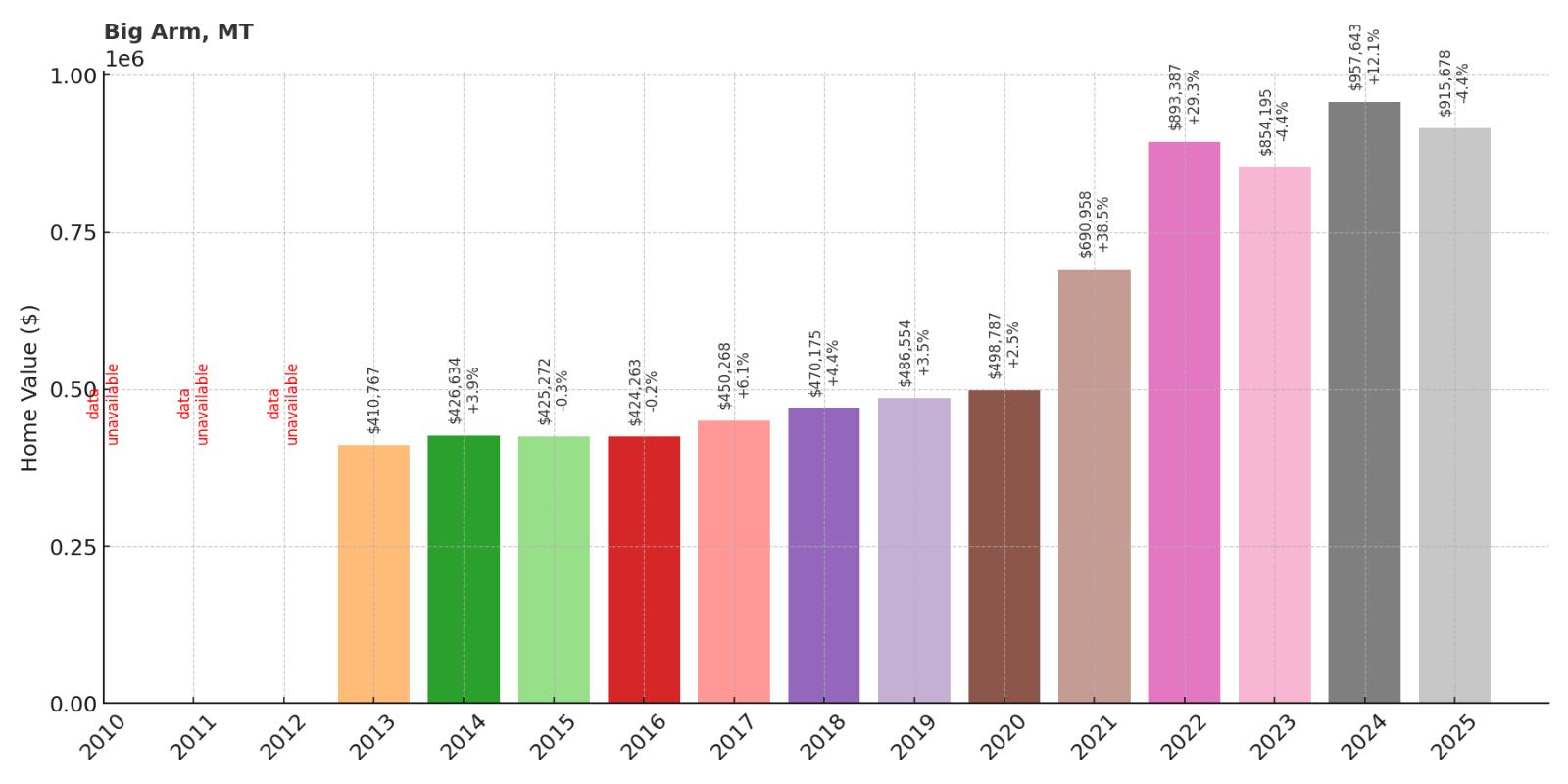
- 2010: N/A
- 2011: N/A
- 2012: N/A
- 2013: $410,767
- 2014: $426,634
- 2015: $425,272
- 2016: $424,263
- 2017: $450,268
- 2018: $470,175
- 2019: $486,554
- 2020: $498,787
- 2021: $690,958
- 2022: $893,387
- 2023: $854,195
- 2024: $957,643
- 2025: $915,678
Big Arm has more than doubled in value since 2013, with current median prices reaching $916,000. The Flathead Lake community showed modest growth through 2020 before pandemic demand drove dramatic appreciation. Recent fluctuations reflect the luxury lakefront market’s volatility, with high-end properties sensitive to broader economic conditions.
Why Big Arm?

Why are people willing to pay so much to live here? What’s special about it?
Big Arm offers direct access to Flathead Lake’s pristine waters with some of the most protected and scenic shoreline in northwest Montana. The community sits in a sheltered bay that provides excellent boating conditions and stunning mountain views across the lake. Properties feature mature landscapes with established trees and gardens that enhance the natural setting.
The area’s appeal centers on waterfront living with privacy and recreational access that rivals more established lake communities. Big Arm Bay provides protection from prevailing winds while maintaining open water access for all types of watercraft. The combination of lakefront lifestyle, mountain views, and proximity to Glacier National Park creates unique value for luxury homebuyers.
How Big Arm Rose to Prominence
Big Arm developed around the natural harbor formed by the bay’s protected waters, initially serving fishing and transportation needs for the broader Flathead Lake region. Early settlement focused on the area’s potential for water-based commerce and recreation, with the natural harbor providing advantages over more exposed shoreline areas. The community remained small and primarily local until the broader discovery of Montana’s recreational appeal.
The transformation to a luxury residential market paralleled the growth of Flathead Lake as a premier recreational destination. Limited developable waterfront property and increasing demand from out-of-state buyers drove property values higher. The area’s reputation for water quality, fishing, and boating attracted buyers seeking lakefront lifestyle without the crowds of more developed resort areas.
3 Interesting Tidbits
1. Protected Waters – Big Arm Bay’s natural configuration provides some of the most protected deep-water anchorage on Flathead Lake, making it ideal for larger watercraft.
2. Wild Horse Connection – The community provides boat access to nearby Wild Horse Island, one of the few places in the region where visitors can observe free-roaming horses in their natural habitat.
3. Lake Depth – The waters off Big Arm reach some of Flathead Lake’s greatest depths, supporting lake trout fishing and maintaining excellent water quality year-round.
4. Pray – 96% Home Price Increase Since 2016
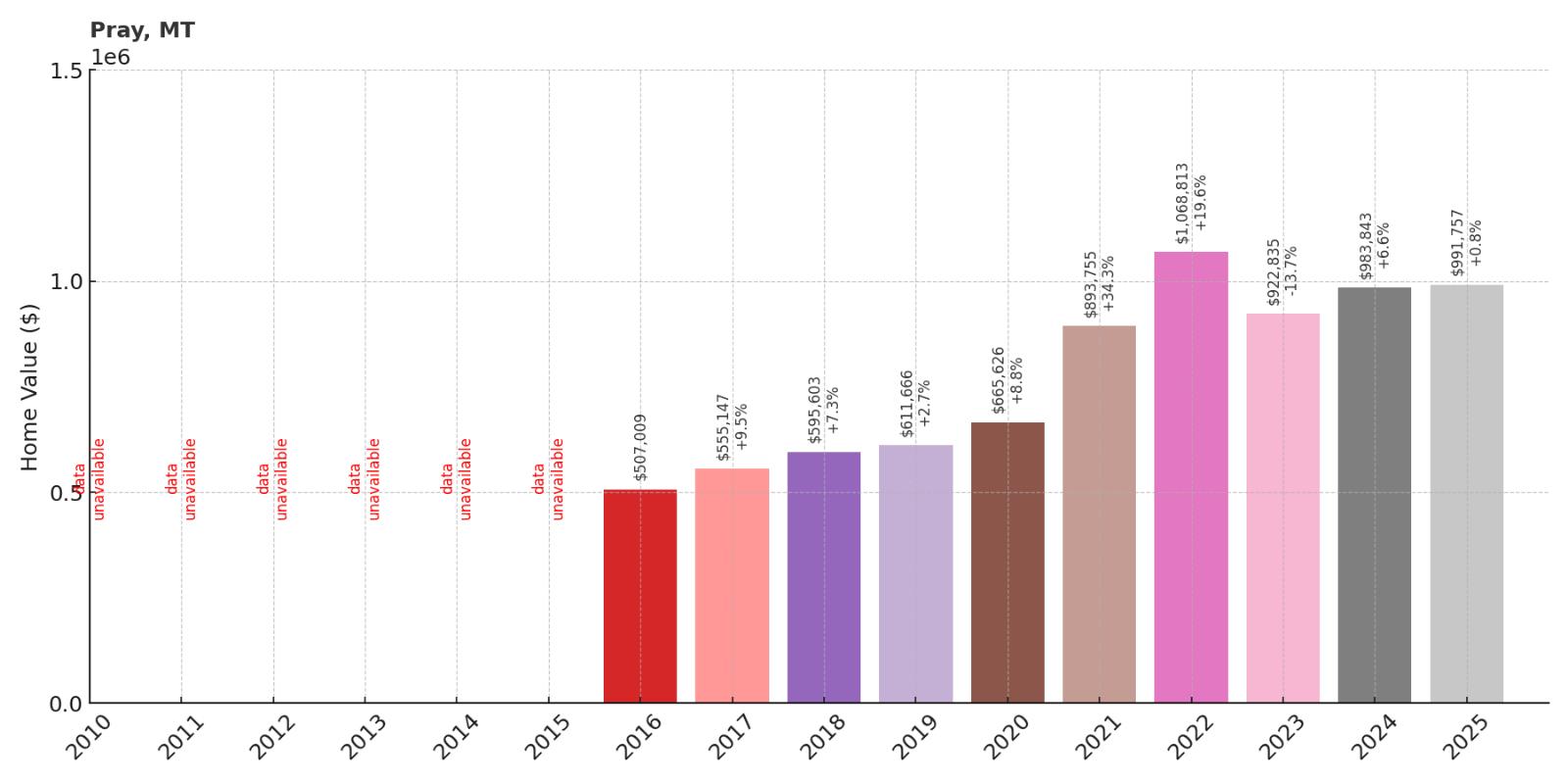
- 2010: N/A
- 2011: N/A
- 2012: N/A
- 2013: N/A
- 2014: N/A
- 2015: N/A
- 2016: $507,009
- 2017: $555,147
- 2018: $595,603
- 2019: $611,666
- 2020: $665,626
- 2021: $893,755
- 2022: $1,068,813
- 2023: $922,835
- 2024: $983,843
- 2025: $991,757
Pray has nearly doubled in value since 2016, reaching $992,000 in median home price by 2025. The community experienced steady appreciation through 2020, followed by pandemic-driven acceleration that peaked in 2022. Recent stabilization around $1 million reflects strong underlying demand for properties near Yellowstone’s northern entrance.
Why Pray?
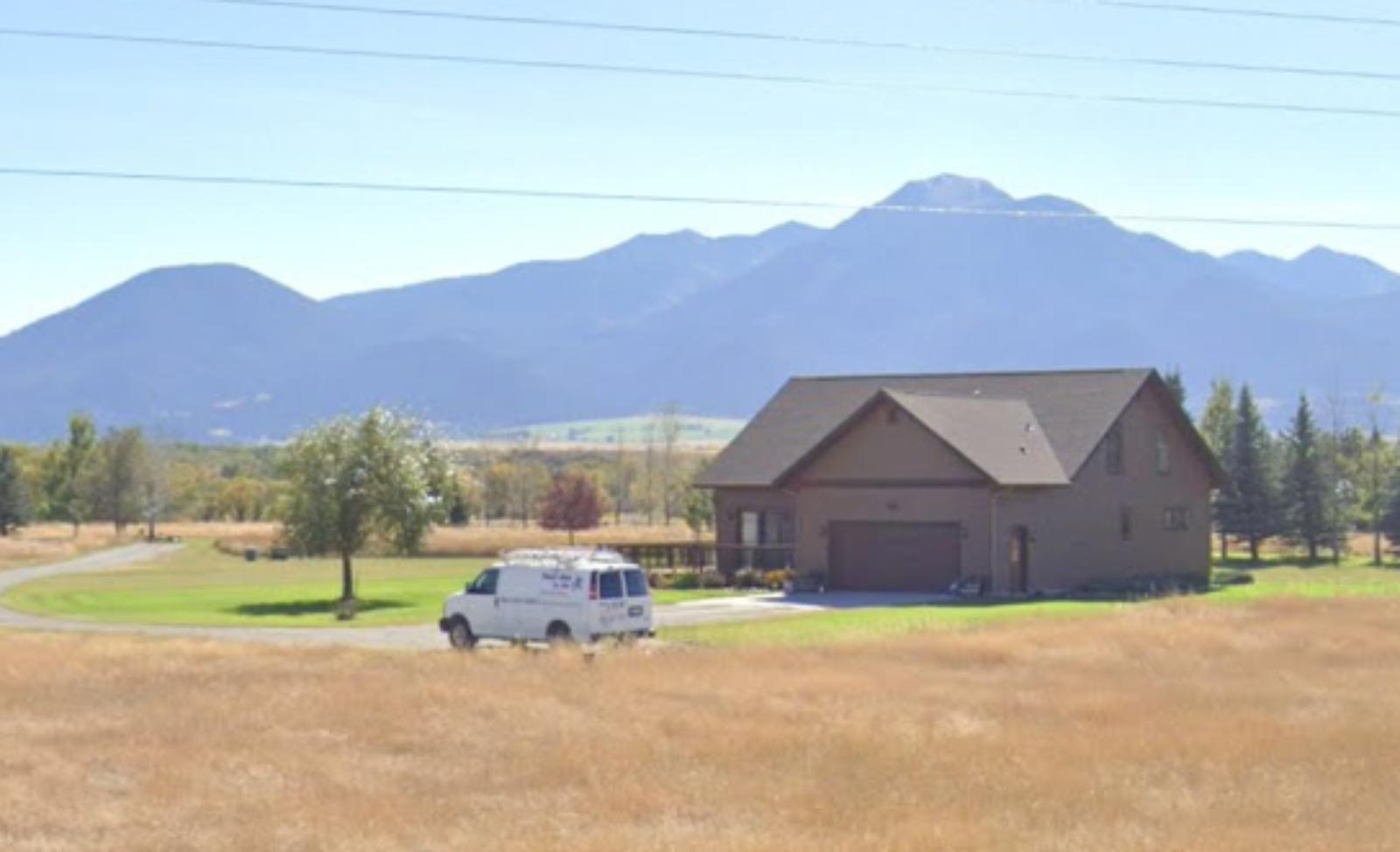
Why are people willing to pay so much to live here? What’s special about it?
Pray sits along the Yellowstone River in Paradise Valley, offering unparalleled access to blue-ribbon trout fishing and mountain recreation. The location provides year-round outdoor activities with Yellowstone National Park’s northern entrance just minutes away via the scenic Yellowstone River corridor. Properties feature expansive valley views framed by the Absaroka and Gallatin mountain ranges.
The community attracts buyers seeking privacy and natural beauty without sacrificing access to world-class amenities. Paradise Valley’s reputation as a fishing destination draws outdoor enthusiasts and celebrities alike, creating demand for luxury properties with river access and mountain views. The area offers both working ranches and custom homes that take advantage of the spectacular setting.
How Pray Rose to Prominence
Pray developed as a small railroad and ranching community in the Yellowstone River valley, serving travelers and settlers moving through Paradise Valley. The area’s agricultural heritage centered on cattle ranching and hay production, taking advantage of the fertile valley floor and abundant water from the Yellowstone River. Early homesteaders were drawn by the combination of productive land and stunning natural setting.
The transition to a luxury residential market began as Yellowstone National Park gained popularity and wealthy visitors discovered the valley’s appeal. Celebrity purchases and high-profile ranches brought national attention to the area’s recreational opportunities and privacy. Recent years have seen continued development of luxury properties as Montana’s appeal to out-of-state buyers has intensified.
3 Interesting Tidbits
1. Fishing Legend – The Yellowstone River through Paradise Valley is considered one of America’s premier trout fishing destinations, attracting anglers from around the world to its pristine waters.
2. Celebrity Haven – Paradise Valley has attracted numerous high-profile residents and visitors, including celebrities and business leaders seeking privacy and outdoor recreation.
3. Valley Views – Pray sits in one of Montana’s most photographed landscapes, with the Yellowstone River meandering through Paradise Valley framed by mountain ranges on both sides.
3. Gallatin Gateway – 229% Home Price Increase Since 2010
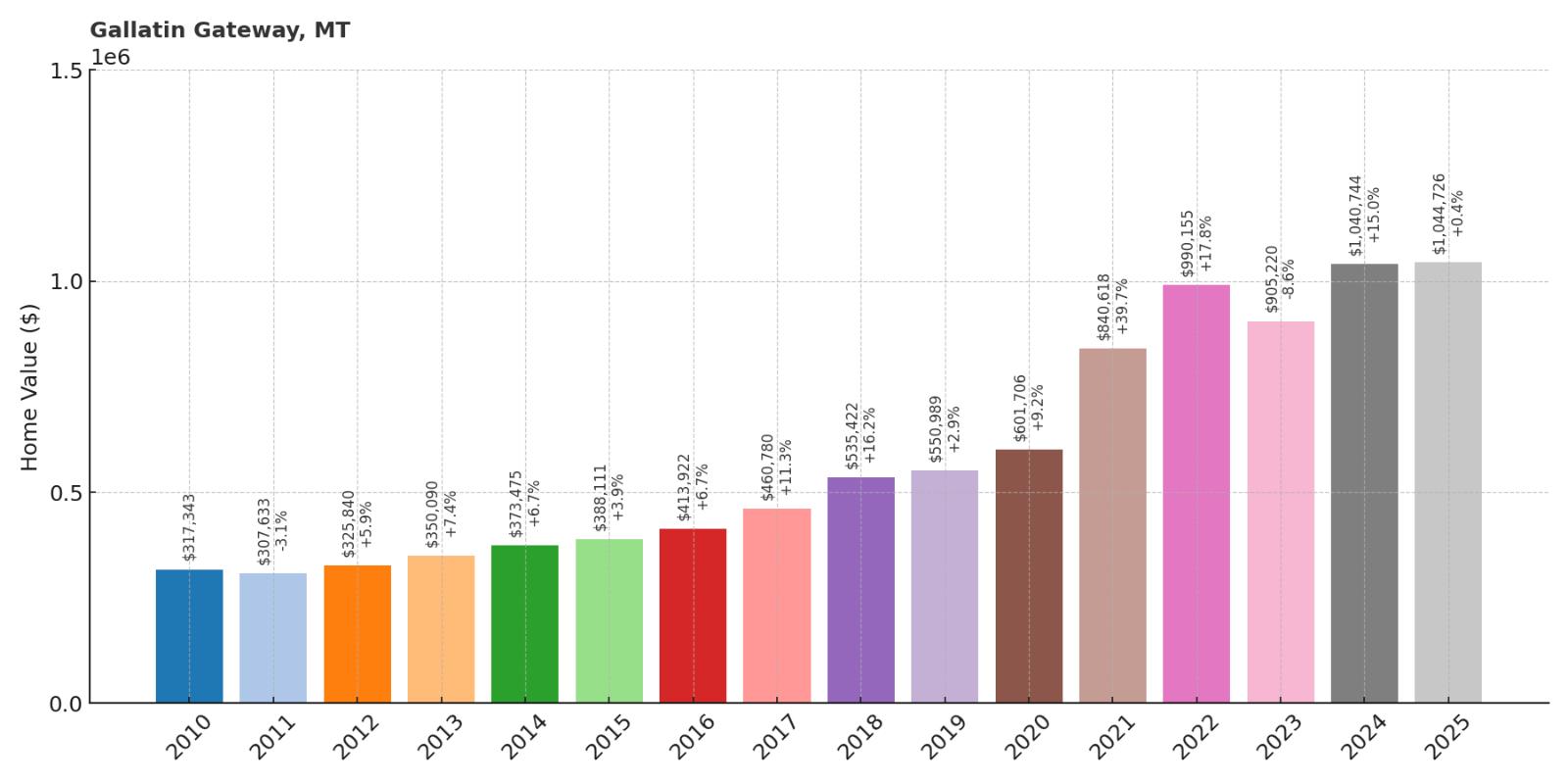
- 2010: $317,343
- 2011: $307,633
- 2012: $325,840
- 2013: $350,090
- 2014: $373,475
- 2015: $388,111
- 2016: $413,922
- 2017: $460,780
- 2018: $535,422
- 2019: $550,989
- 2020: $601,706
- 2021: $840,618
- 2022: $990,155
- 2023: $905,220
- 2024: $1,040,744
- 2025: $1,044,726
Gallatin Gateway has posted the strongest percentage gains on this list, with home values climbing 229% since 2010 to over $1 million. The community experienced steady growth through the 2010s before explosive appreciation during the pandemic years. Values have stabilized above $1 million since 2024, establishing Gallatin Gateway as one of Montana’s premier residential markets.
Why Gallatin Gateway?

Why are people willing to pay so much to live here? What’s special about it?
Gallatin Gateway serves as an essential junction between Bozeman, Belgrade, Big Sky, and Ennis, functioning as a gateway for travelers heading to Yellowstone National Park. The location offers immediate access to world-class recreation including the Gallatin River for fly fishing and quick drives to Big Sky Resort or Yellowstone. Properties grant easy access to local treasures such as Palisade Falls and iconic Yellowstone Park, just an hour and a half to the south.
The area combines rural Montana charm with sophisticated amenities and strategic location advantages. The community features a restored vintage clock tower and the historic Gallatin Gateway Inn maintained in all its 1920s era glory. Properties range from luxury ranches with mountain views to custom homes on spacious acreage, offering both privacy and convenient access to Bozeman’s urban amenities just 20 minutes north.
How Gallatin Gateway Rose to Prominence
Gallatin Gateway began as a railroad town in the 1920s, serving as the original northern entrance to Yellowstone National Park. The historic Gallatin Gateway Inn was built to accommodate wealthy railroad passengers traveling to the park, establishing the area’s connection to luxury tourism from its earliest days. The railroad brought visitors through the scenic Gallatin Canyon, showcasing the area’s natural beauty and recreation potential.
Modern development accelerated as Bozeman’s growth pushed outward and Big Sky Resort gained international recognition. The community’s position at the intersection of major recreational destinations made it increasingly valuable to buyers seeking access to multiple amenities. Recent years have seen development of luxury ranches and custom homes that take advantage of mountain views and proximity to blue-ribbon fishing waters.
3 Interesting Tidbits
1. Historic Railroad Hub – The original Gallatin Gateway Inn was designed as a luxury stopover for railroad passengers en route to Yellowstone, featuring Spanish Colonial Revival architecture that still stands today.
2. Fishing Paradise – The nearby Gallatin River is considered one of Montana’s premier blue-ribbon trout streams, with public access points providing world-class fly fishing just minutes from town.
3. Park Gateway Legacy – Before the current road system, Gallatin Gateway served as the primary northern entrance to Yellowstone National Park, with stagecoaches carrying visitors through the scenic canyon.
2. Rollins – 177% Home Price Increase Since 2013
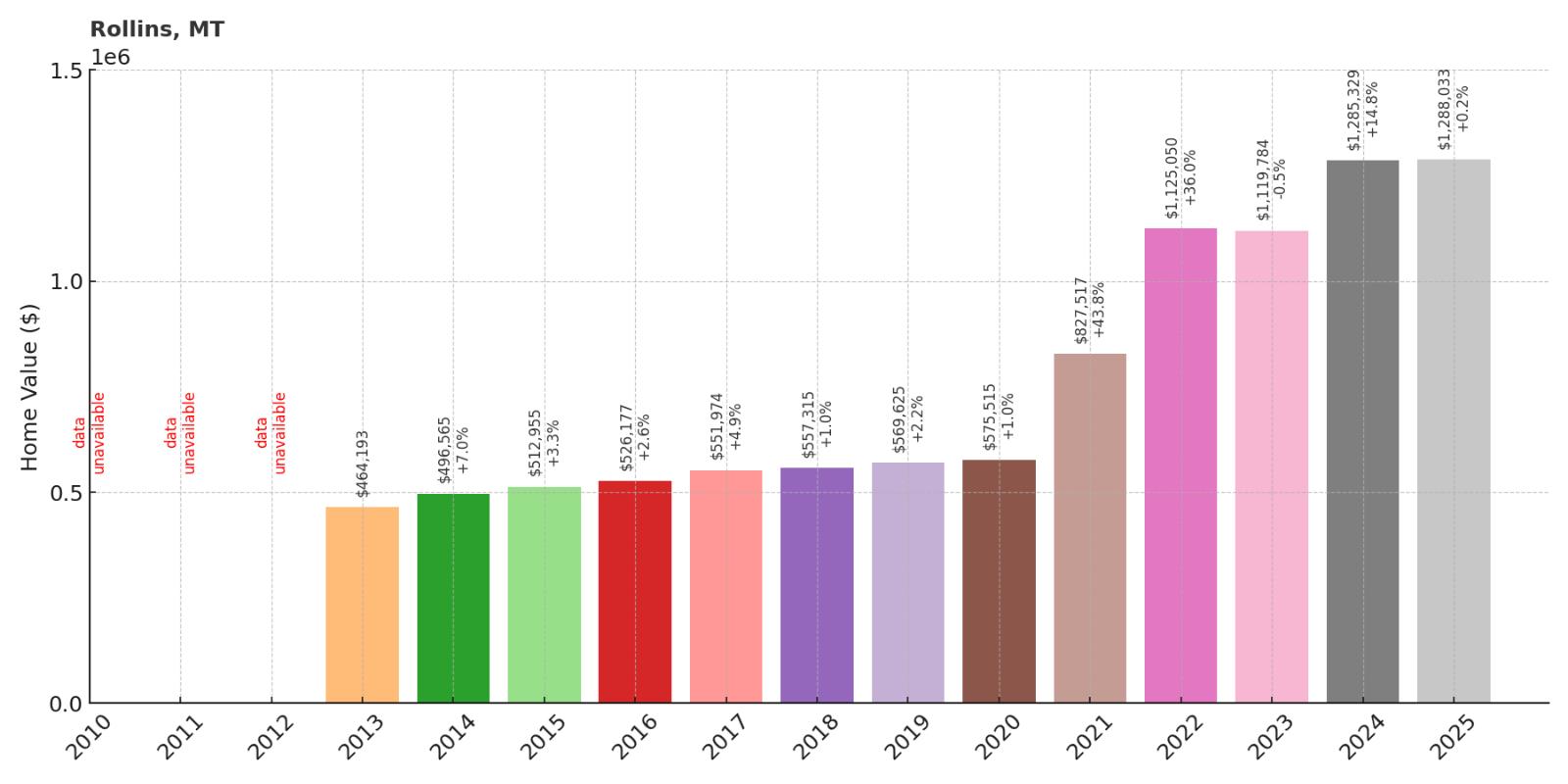
- 2010: N/A
- 2011: N/A
- 2012: N/A
- 2013: $464,193
- 2014: $496,565
- 2015: $512,955
- 2016: $526,177
- 2017: $551,974
- 2018: $557,315
- 2019: $569,625
- 2020: $575,515
- 2021: $827,517
- 2022: $1,125,050
- 2023: $1,119,784
- 2024: $1,285,329
- 2025: $1,288,033
Rollins has experienced remarkable growth, with median home values nearly tripling since 2013 to reach $1.29 million in 2025. The community’s position on Flathead Lake’s eastern shore has driven consistent appreciation, with particularly strong gains during the pandemic years. The steady climb from 2013 through 2020 accelerated dramatically in 2021, reflecting Montana’s broader luxury real estate boom.
Why Rollins?
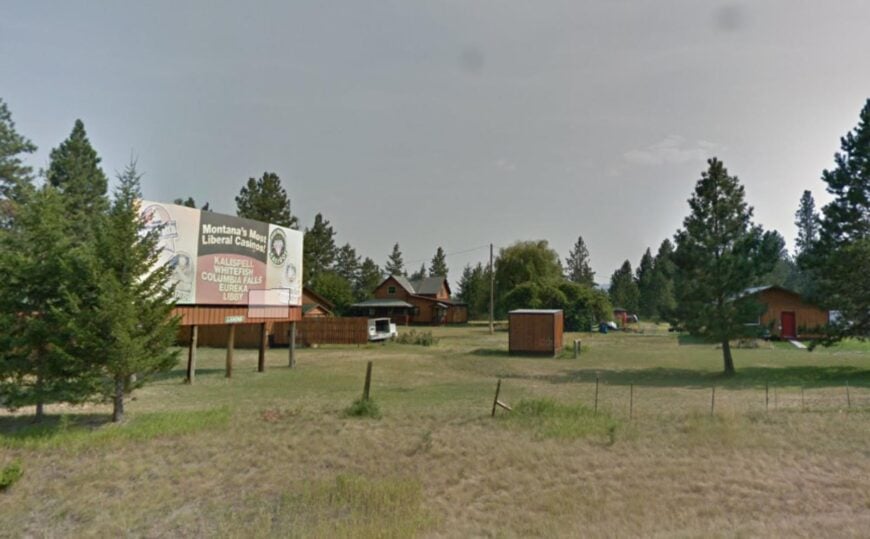
Why are people willing to pay so much to live here? What’s special about it?
Flathead Lake is among the largest natural freshwater lakes west of the Mississippi River, covering 191 square miles with water quality studies showing it ranks among the cleanest in the world. Rollins sits on the lake’s eastern shore, offering direct access to pristine waters for boating, fishing, and swimming. Properties feature rare lakefront acreage with private waterfront access, including parcels with 450 feet of private Flathead Lake frontage.
The community combines luxury lakefront living with mountain views and proximity to recreational activities year-round. Wild Horse Island, located in Big Arm Bay near Rollins, provides 2,100 acres managed by Montana Fish, Wildlife and Parks where visitors can see bighorn sheep and wild horses. This unique combination of water access, wildlife viewing, and mountain recreation creates an unmatched lifestyle that commands premium prices.
How Rollins Rose to Prominence
Rollins developed as a lakeside community in the early 1900s when the railroad brought visitors to Flathead Lake’s pristine waters. Originally a stop along the route to Glacier National Park, the town grew around tourism and recreation rather than industry or agriculture. The natural deep-water harbor at Canal Bay made it an ideal location for boat access and water activities.
Modern Rollins emerged as demand for luxury lakefront properties exploded across the Mountain West. Limited developable lakefront combined with Montana’s appeal to out-of-state buyers created intense competition for properties. The community’s small size and exclusive feel attracted high-net-worth individuals seeking privacy and natural beauty, driving property values to current levels that compete with exclusive lake communities nationwide.
3 Interesting Tidbits
1. Lake Giants – Flathead Lake averages 164 feet deep with a maximum depth of 370 feet, making it one of the deepest natural lakes in the western United States.
2. Wild Horse Sanctuary – The nearby Wild Horse Island is home to one of the last free-roaming horse herds in the region, creating a unique wildlife viewing experience accessible only by boat.
3. Crystal Waters – Studies conducted at the Flathead Lake Biological Station show the lake’s water quality ranks among the cleanest in the world, supporting the area’s premium real estate values.
1. Big Sky – 145% Home Price Increase Since 2016
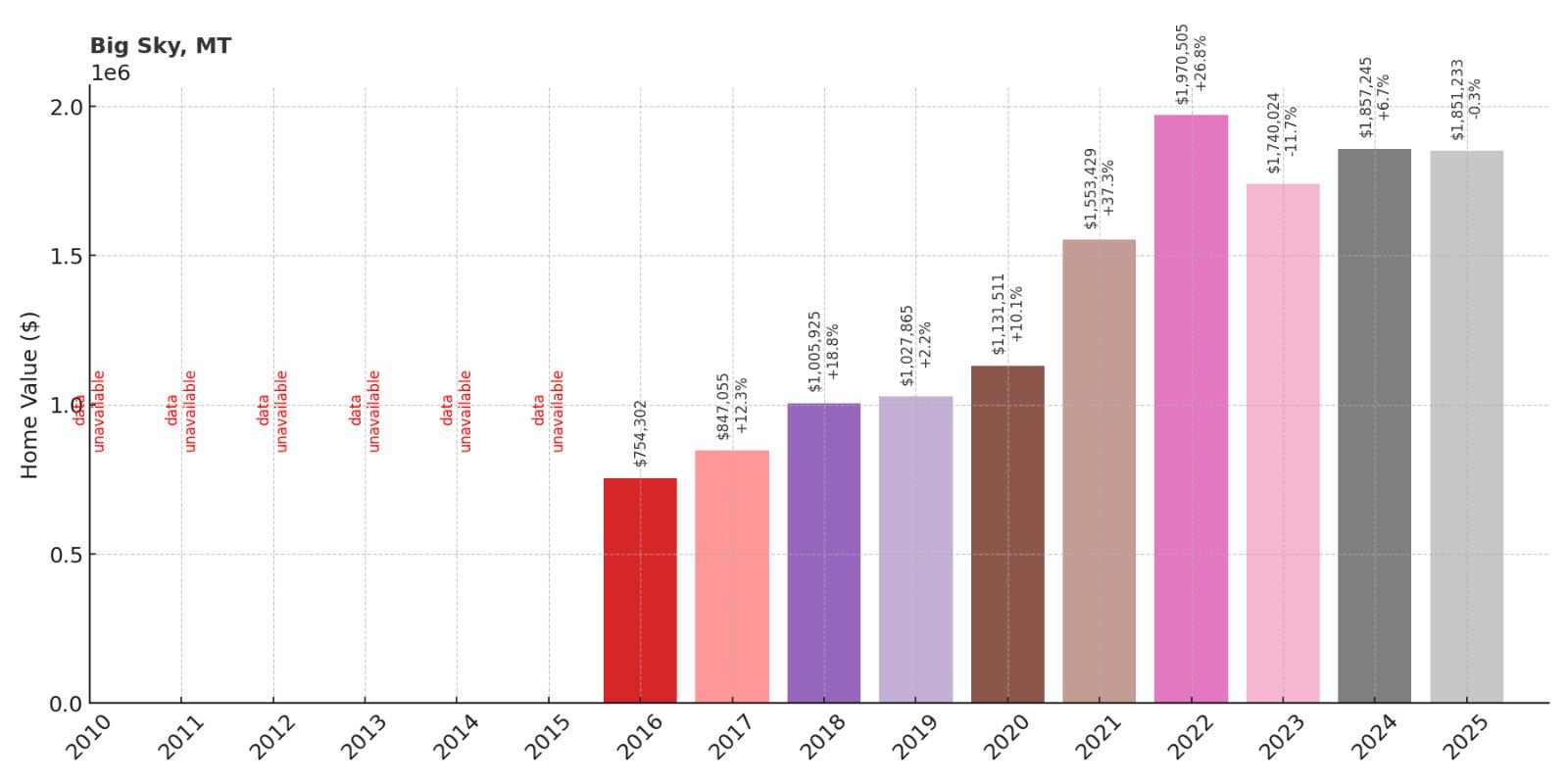
- 2010: N/A
- 2011: N/A
- 2012: N/A
- 2013: N/A
- 2014: N/A
- 2015: N/A
- 2016: $754,302
- 2017: $847,055
- 2018: $1,005,925
- 2019: $1,027,865
- 2020: $1,131,511
- 2021: $1,553,429
- 2022: $1,970,505
- 2023: $1,740,024
- 2024: $1,857,245
- 2025: $1,851,233
Big Sky has maintained its position as Montana’s most expensive residential market, with homes averaging $1.85 million in 2025. The 145% price surge since 2016 peaked during the pandemic years, when remote work and lifestyle changes drove unprecedented demand. Current prices have stabilized slightly from the 2022 peak of nearly $2 million, reflecting a more balanced luxury market.
Why Big Sky?

Why are people willing to pay so much to live here? What’s special about it?
Big Sky attracts buyers seeking the ultimate mountain lifestyle with world-class skiing at Big Sky Resort and exclusive private clubs like Spanish Peaks Mountain Club and Moonlight Basin. The area features three exclusive ski/golf communities and offers everything from multi-million dollar ski-in, ski-out homes to condos in Town Center. Proximity to Yellowstone National Park, just an hour away, adds to the appeal for outdoor enthusiasts and investors alike.
The area’s dynamic growth includes several prestigious new developments, with projects like One&Only Moonlight Basin featuring 72 guest rooms and suites, 19 guest cabins, and 62 private homes. This combination of exclusive amenities, natural beauty, and limited developable land creates sustained demand that justifies premium pricing. The community offers both luxury and adventure in one of America’s most pristine mountain settings.
How Big Sky Rose to Prominence
Big Sky’s transformation began in the 1970s when media mogul Chet Huntley founded the resort community as a destination ski area. The vision was to create a world-class resort that could compete with established destinations like Aspen and Vail. Strategic location at the base of Lone Peak, combined with reliable snowfall and vast terrain, provided the foundation for what would become one of America’s premier ski destinations.
The addition of private clubs and luxury developments in the 1990s and 2000s elevated Big Sky beyond a typical ski town. Spanish Peaks Mountain Club and Moonlight Basin brought ultra-high-net-worth individuals to the area, creating a market for multi-million-dollar properties. Recent developments include partnerships with global luxury brands, with One&Only Resort at Moonlight Basin representing the first U.S. location for the prestigious hotel group.
3 Interesting Tidbits
1. Ski Territory Giant – Big Sky Resort boasts over 5,800 acres of skiable terrain, making it one of the largest ski areas in North America with minimal lift lines.
2. Exclusive Club Culture – The Yellowstone Club, located within Big Sky, is one of the world’s most exclusive private ski and golf clubs, with initiation fees reportedly exceeding $400,000.
3. Wildlife Corridor – The area has a major wildfire risk, with 99% of properties having some wildfire risk over the next 30 years, but also serves as a critical wildlife migration corridor connecting Yellowstone to other protected lands.





